Air-Quality Challenges of Prescribed Fire in the Complex Terrain and Wildland Urban Interface Surrounding Bend, Oregon
Abstract
1. Introduction
2. Methods
2.1. Study Area
2.2. Acceptable Burn Days
2.3. Seasonal and Diurnal Wind Analysis
2.4. Smoldering Fuel Consumption Measurements
2.5. Weather and PM2.5 Measurement Stations
2.6. Smoke Dispersion Modeling
3. Results
3.1. Acceptable Burn Days
3.2. Seasonal and Diurnal Wind Analysis
3.3. Smoke Intrusions
4. Discussion
4.1. Acceptable Burn Days
4.2. Seasonal and Diurnal Wind Analysis
4.3. Smoke Intrusions
4.4. Future Directions
5. Conclusions
Author Contributions
Funding
Acknowledgments
Conflicts of Interest
Appendix A
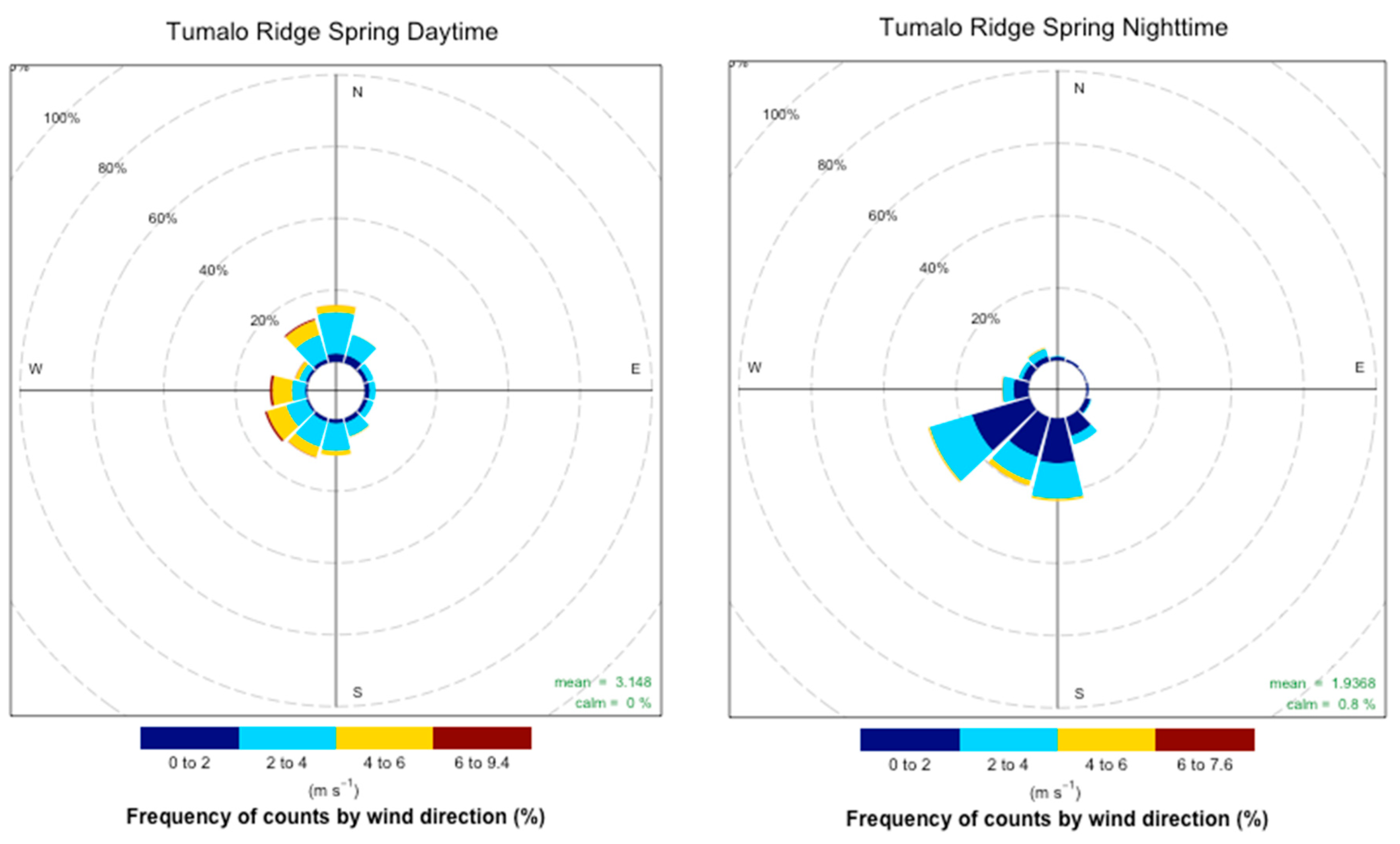
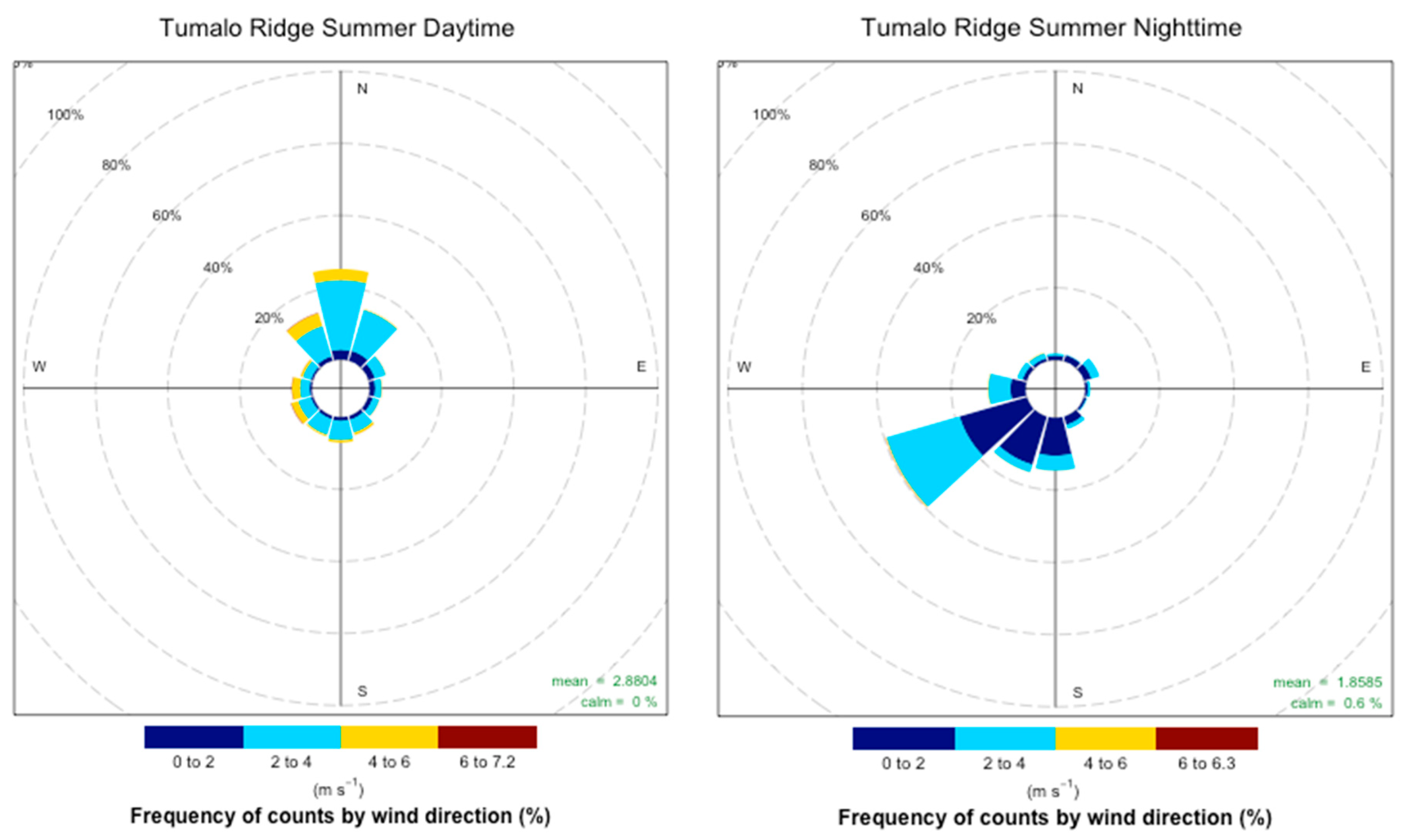
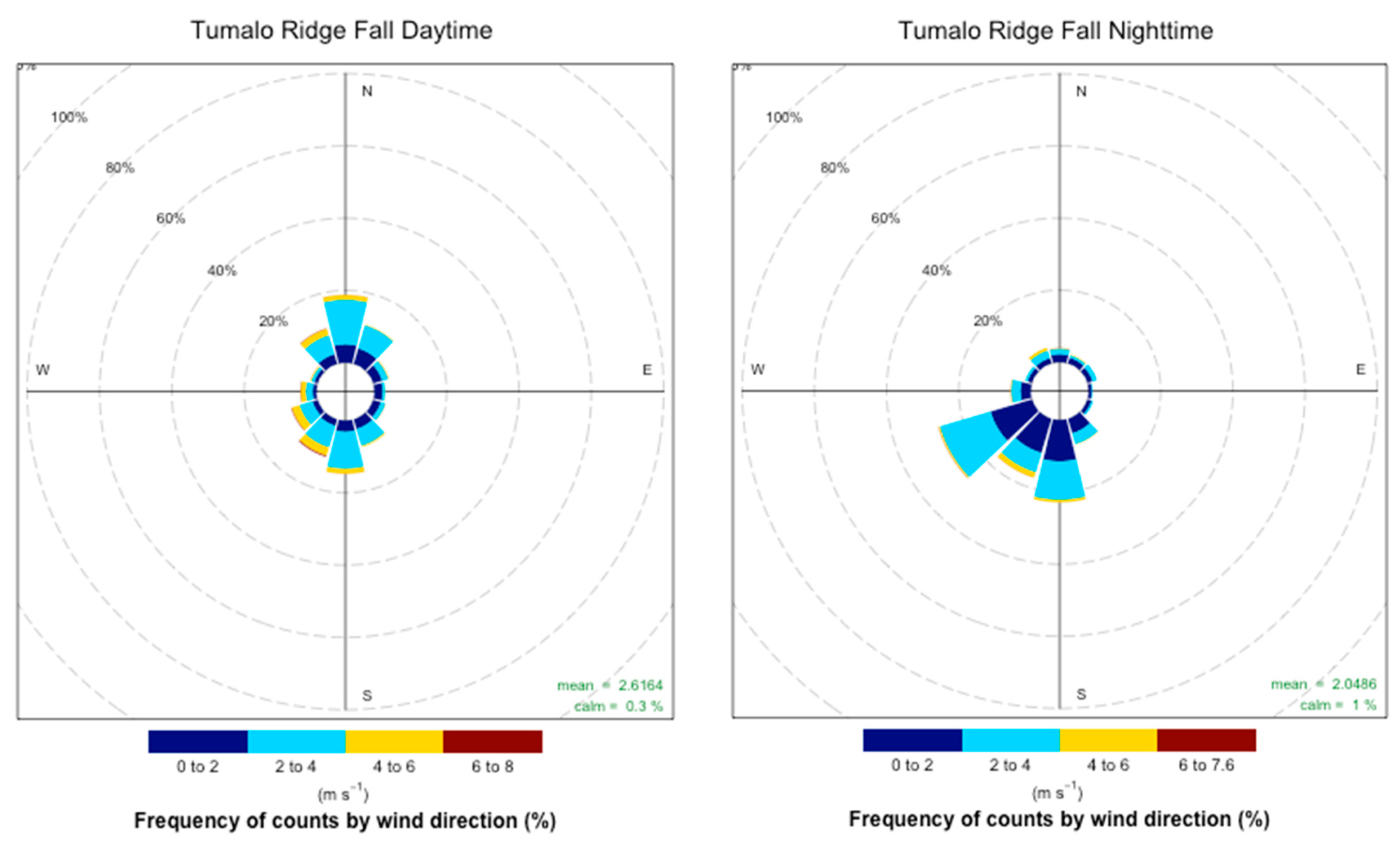
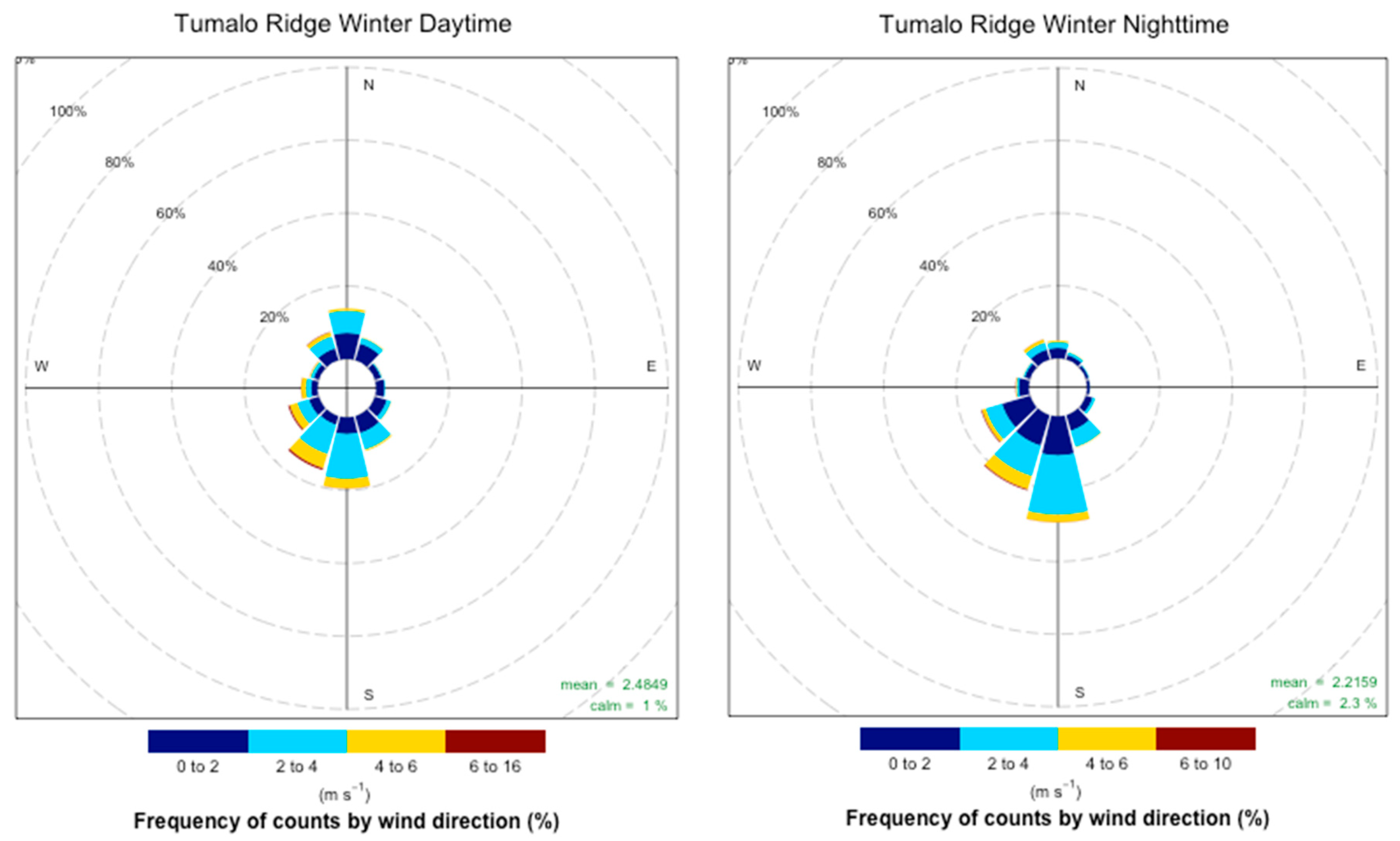
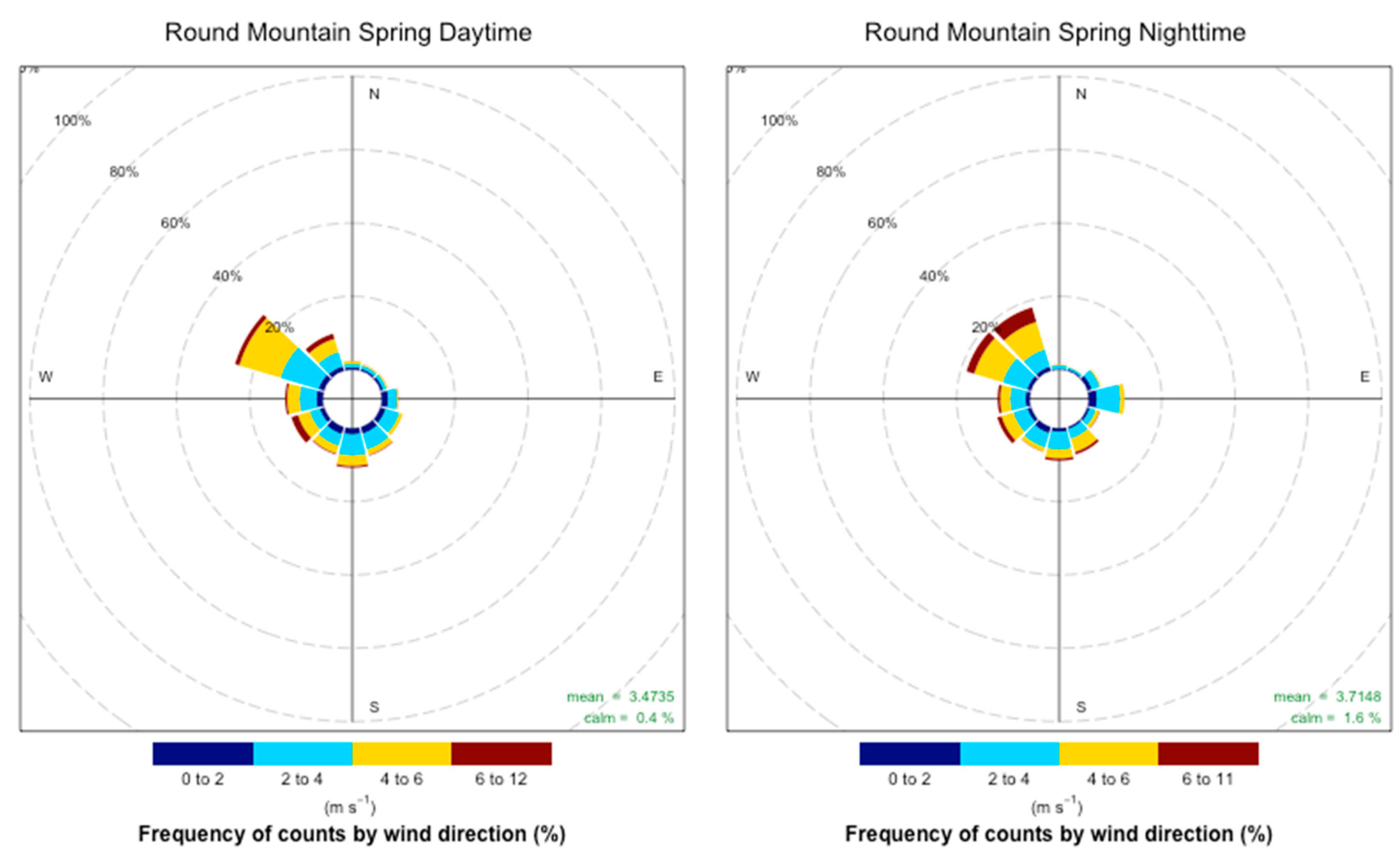

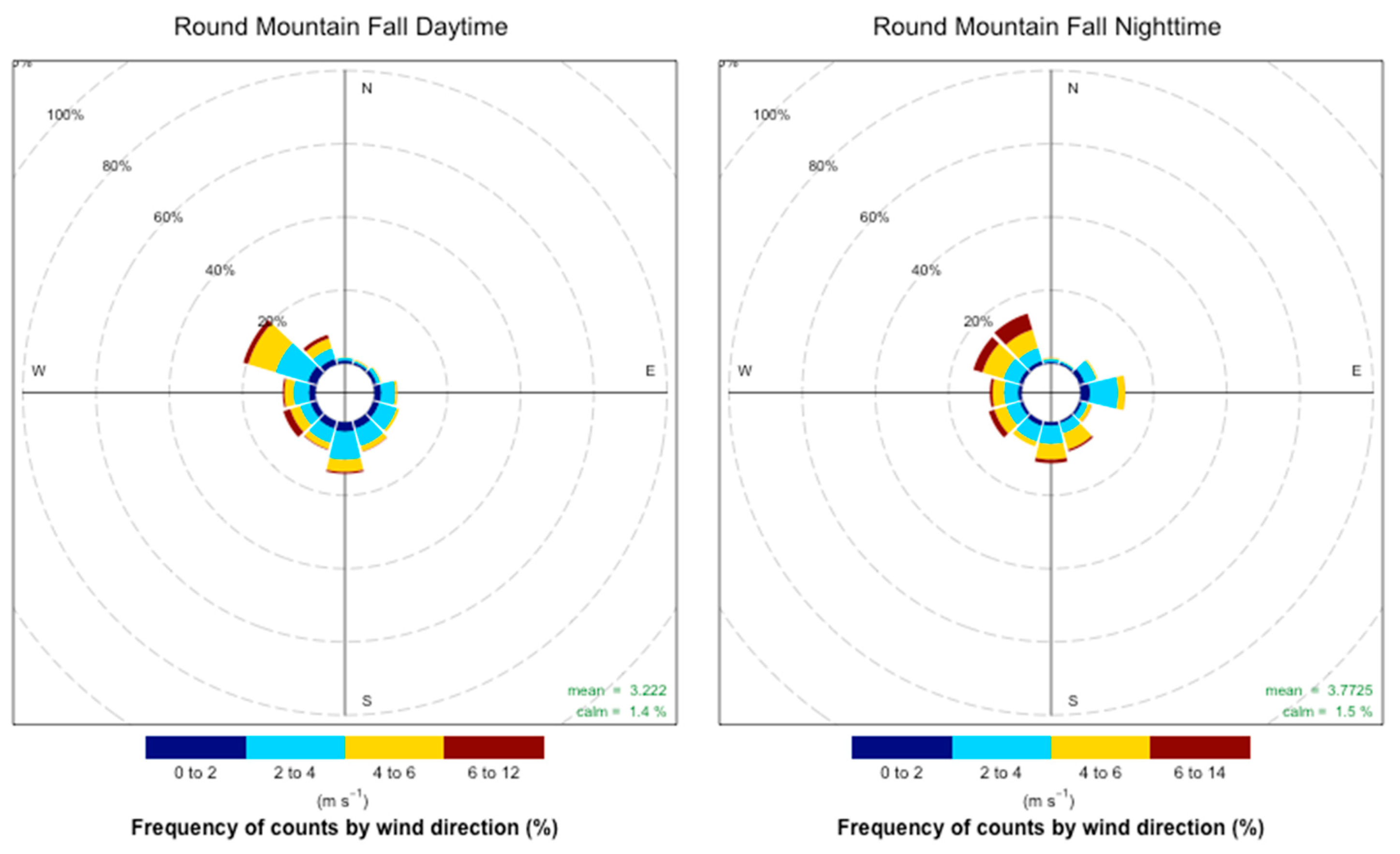
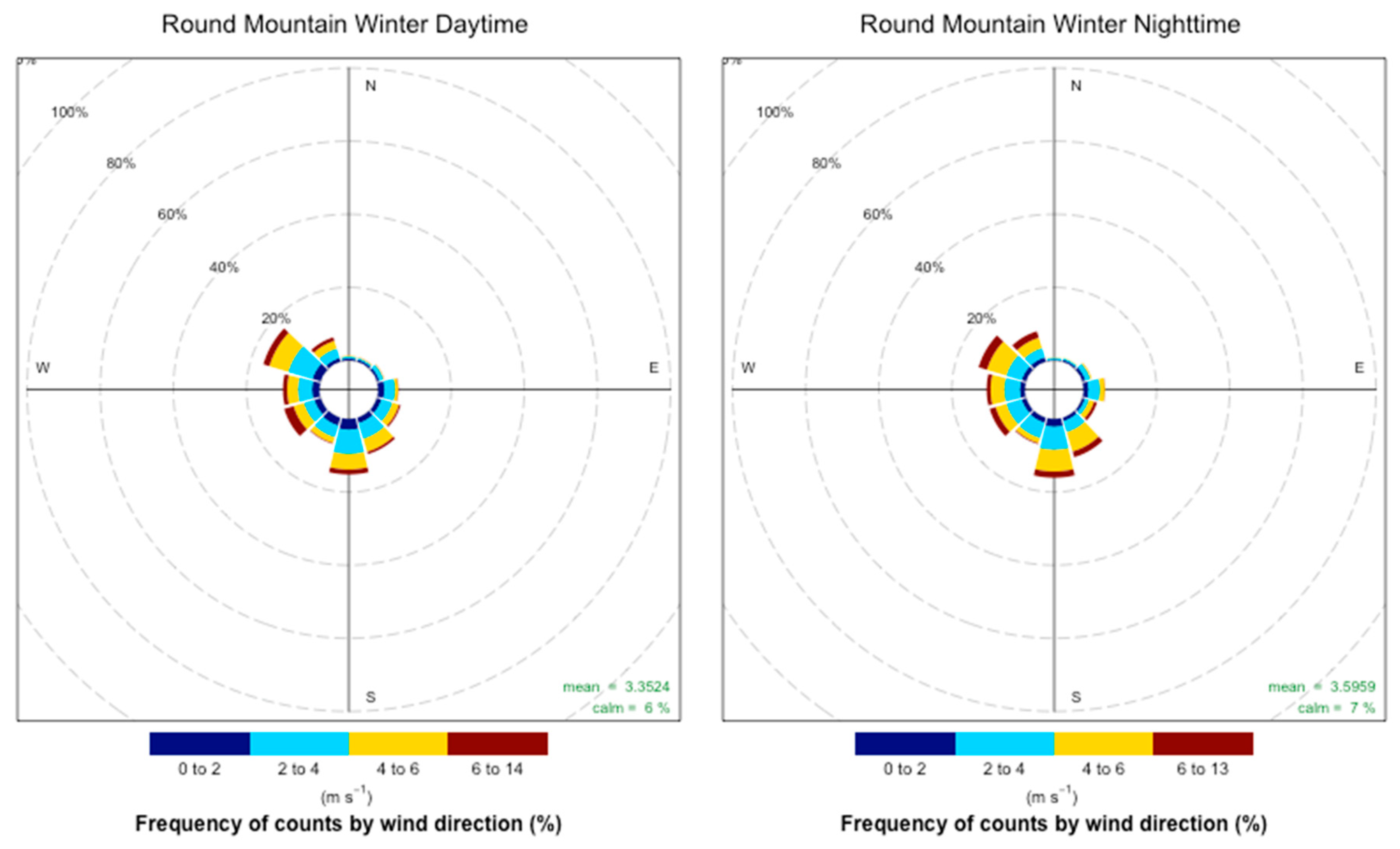
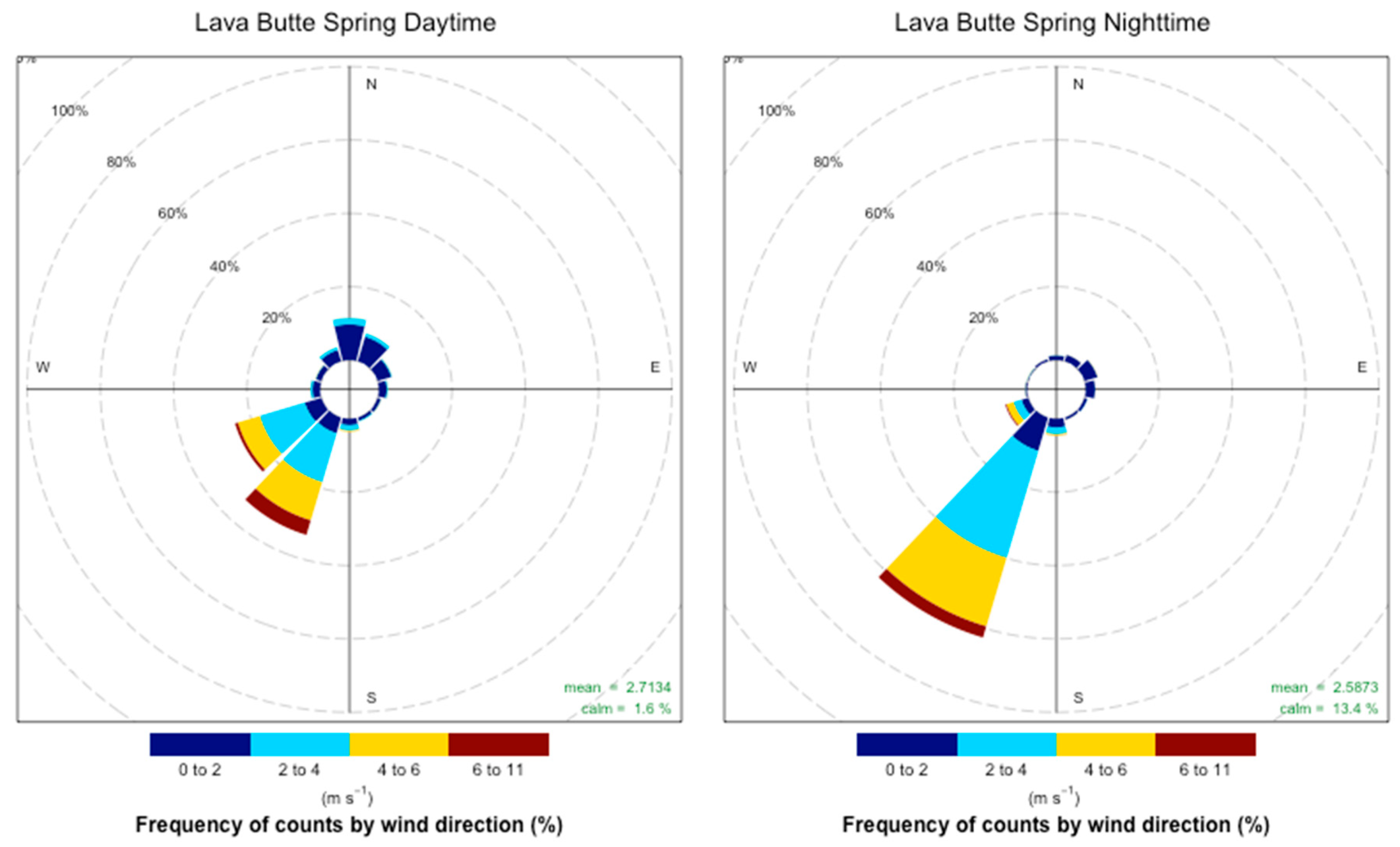

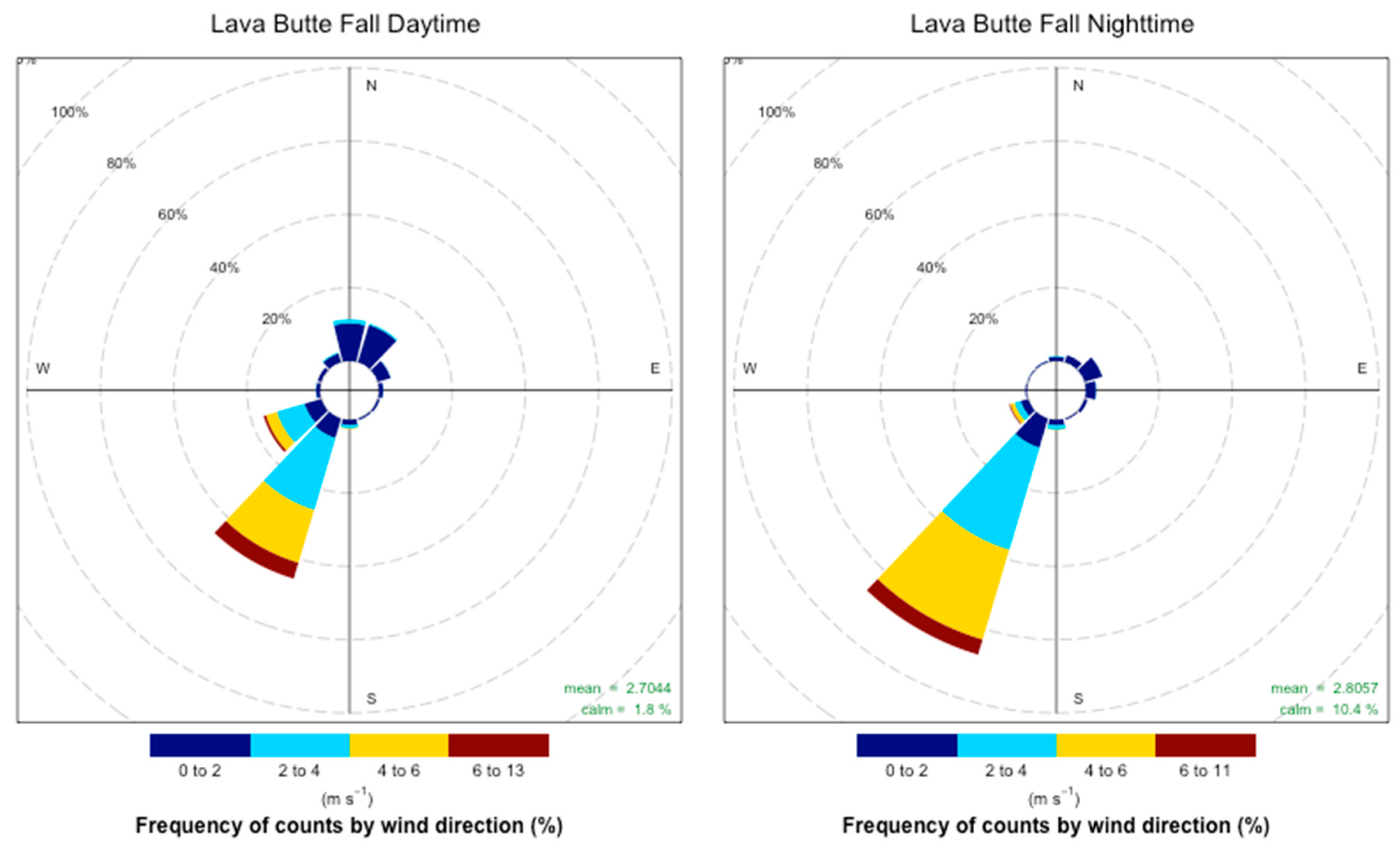
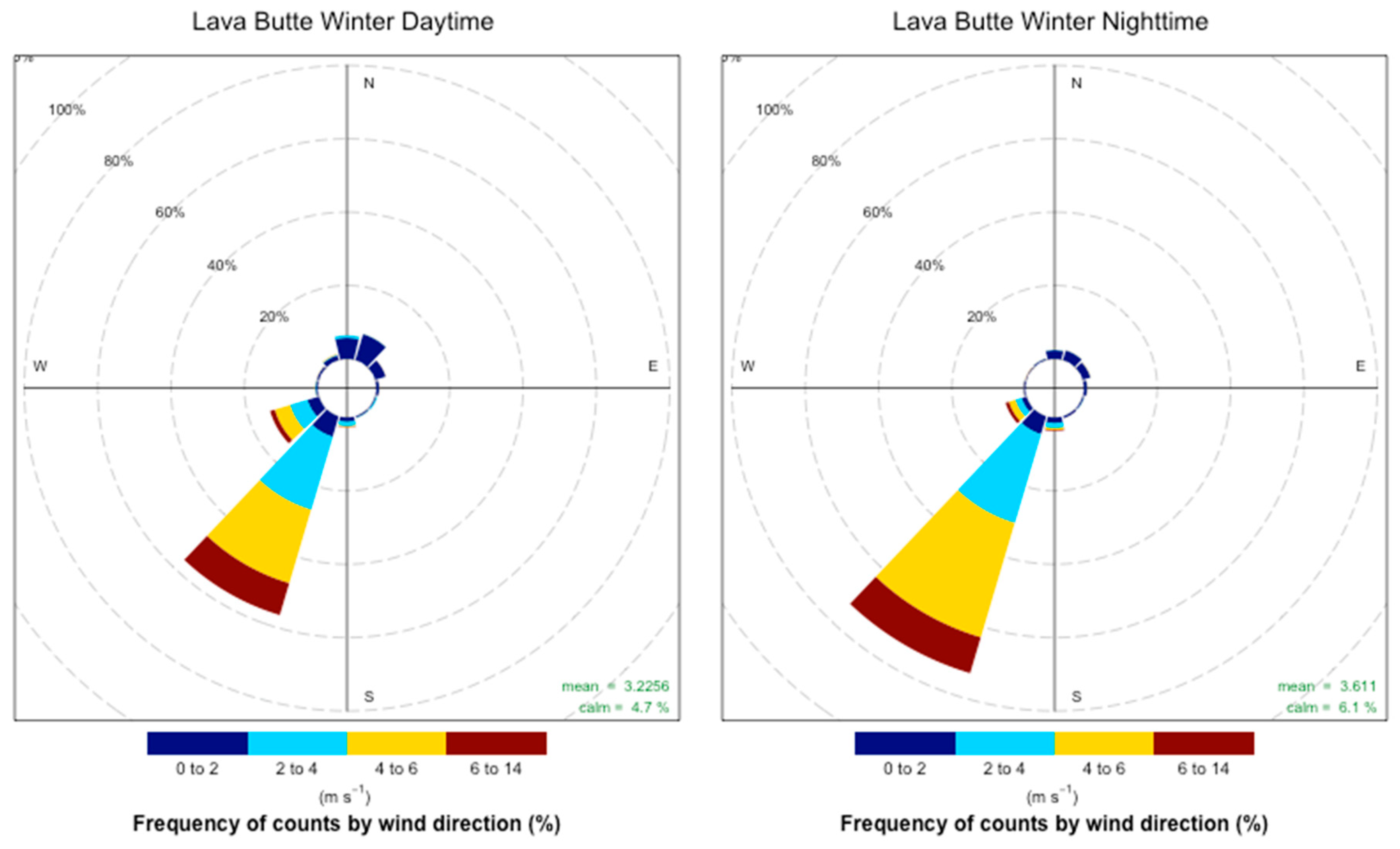
Appendix B
| Meteorological Model | Location | Station Type | Time | WS Bias (m∙s−1) | WS Error (m∙s−1) | WD Error (°) | % Calm |
|---|---|---|---|---|---|---|---|
| 1-km NAM | Lava Butte | RAWS | Day | 0.18 | 0.50 | 81.48 | 25% |
| Night | −0.35 | 0.64 | 20.39 | 0% | |||
| 1-km NAM | Round Mountain | RAWS | Day | −1.77 | 1.77 | 45.99 | 0% |
| Night | −0.75 | 1.19 | 80.49 | 0% | |||
| 1-km NAM | Tumalo Ridge | RAWS | Day | −1.17 | 1.22 | 55.46 | 0% |
| Night | 0.24 | 0.51 | 36.40 | 0% | |||
| 4-km WRF | Lava Butte | RAWS | Day | 0.21 | 0.35 | 50.86 | 25% |
| Night | 0.19 | 0.74 | 8.99 | 0% | |||
| 4-km WRF | Round Mountain | RAWS | Day | −1.58 | 1.60 | 60.88 | 0% |
| Night | −0.84 | 1.36 | 84.46 | 0% | |||
| 4-km WRF | Tumalo Ridge | RAWS | Day | −1.03 | 1.03 | 35.13 | 0% |
| Night | 0.01 | 0.59 | 92.62 | 0% |
| Location | Station Type | WS Bias (m∙s−1) | WS Error (m∙s−1) | WD Error (°) | % Calm |
|---|---|---|---|---|---|
| Sisters Ranger Station | WX | 4.99 | 4.99 | 31.58 | 13% |
| Bridges Boys Academy | WX | 2.02 | 2.02 | 43.07 | 0% |
| Cascade Academy | WX | 2.16 | 2.16 | 49.95 | 38% |
| Tumalo Ridge | RAWS | 2.07 | 2.07 | 17.35 | 0% |
| Cascade Middle School | PM2.5 | 0.54 | 0.85 | 42.04 | 0% |
| Lava Butte | RAWS | 1.93 | 1.93 | 18.53 | 0% |
| Sunriver | PM2.5 | - | - | - | 100% |
| Round Mountain | RAWS | 1.58 | 1.58 | 7.56 | 0% |
| Location | Station Type | Time | WS Bias (m∙s−1) | WD Bias (m∙s−1) | WD Error (°) | % Calm |
|---|---|---|---|---|---|---|
| Sisters Ranger Station | WX | Day | 3.88 | 3.88 | 27.45 | 25% |
| Night | Calm | Calm | Calm | 100% | ||
| Bridges Boys Academy | WX | Day | 1.66 | 1.66 | 38.34 | 0% |
| Night | 1.30 | 1.30 | Calm | 86% | ||
| Cascade Academy | WX | Day | 2.14 | 2.14 | 46.67 | 13% |
| Night | Calm | Calm | Calm | 100% | ||
| Miller Elementary | WX | Day | 1.20 | 1.40 | 27.29 | 0% |
| Night | 1.13 | 1.13 | Calm | 86% | ||
| Tumalo Ridge | RAWS | Day | 0.40 | 0.72 | 30.83 | 0% |
| Night | −0.47 | 0.50 | 51.13 | 0% | ||
| Cascade Middle School | PM2.5 | Day | 0.92 | 0.92 | 29.58 | 0% |
| Night | 0.16 | 0.25 | 107.52 | 0% | ||
| Lava Butte | RAWS | Day | 2.48 | 2.48 | 33.71 | 0% |
| Night | −1.07 | 1.53 | Calm | 57% | ||
| Sunriver | PM2.5 | Day | −1.56 | 1.64 | 63.74 | 0% |
| Night | 0.00 | 0.73 | 123.69 | 0% | ||
| Round Mountain | RAWS | Day | 1.27 | 1.27 | 7.69 | 0% |
| Night | −0.71 | 0.87 | 14.19 | 0% |
| Location | Station Type | Time | WS Bias (m∙s−1) | WS Error (m∙s−1) | WD Error (°) | % Calm |
|---|---|---|---|---|---|---|
| Sisters Ranger Station | WX | Day | 2.01 | 2.01 | Calm | 75% |
| Night | Calm | Calm | Calm | 100% | ||
| Bridges Boys Academy | WX | Day | 1.08 | 1.35 | 51.25 | 0% |
| Night | Calm | Calm | Calm | 100% | ||
| Cascade Academy | WX | Day | 1.29 | 1.29 | 50.08 | 25% |
| Night | Calm | Calm | Calm | 100% | ||
| Miller Elementary | WX | Day | 2.26 | 2.26 | 49.34 | 50% |
| Night | 0.06 | 0.06 | Calm | 86% | ||
| Tumalo Ridge | RAWS | Day | 0.91 | 0.95 | 54.46 | 0% |
| Night | 0.00 | 0.94 | 93.37 | 0% | ||
| Cascade Middle School | PM2.5 | Day | 0.48 | 0.60 | 61.93 | 0% |
| Night | 0.02 | 1.16 | 108.17 | 0% | ||
| Lava Butte | RAWS | Day | 1.47 | 1.47 | 25.94 | 0% |
| Night | −0.55 | 0.87 | Calm | 57% | ||
| Sunriver | PM2.5 | Day | −0.30 | 1.13 | 68.54 | 0% |
| Night | 0.82 | 1.31 | 125.68 | 0% | ||
| Round Mountain | RAWS | Day | 1.18 | 1.30 | 74.58 | 0% |
| Night | −1.37 | 1.37 | 86.29 | 0% |
| Location | Station Type | Time | WS Bias (m∙s−1) | WS Error (m∙s−1) | WD Error (°) | % Calm |
|---|---|---|---|---|---|---|
| Sisters Ranger Station | WX | Day | 3.22 | 3.22 | Calm | 63% |
| Night | Calm | Calm | Calm | 100% | ||
| Bridges Boys Academy | WX | Day | 0.81 | 0.84 | 28.52 | 0% |
| Night | 1.68 | 1.68 | 8.96 | 43% | ||
| Cascade Academy | WX | Day | 3.63 | 3.63 | 30.81 | 0% |
| Night | Calm | Calm | Calm | 100% | ||
| Miller Elementary | WX | Day | 3.04 | 3.04 | 28.52 | 0% |
| Night | Calm | Calm | Calm | 100% | ||
| Tumalo Ridge | RAWS | Day | 1.61 | 1.61 | 18.25 | 0% |
| Night | 0.82 | 0.82 | 42.75 | 0% | ||
| Cascade Middle School | PM2.5 | Day | 1.65 | 1.65 | 35.82 | 0% |
| Night | 1.02 | 1.02 | 121.68 | 0% | ||
| Lava Butte | RAWS | Day | 3.87 | 3.87 | 23.98 | 0% |
| Night | 0.64 | 0.64 | Calm | 71% | ||
| Sunriver | PM2.5 | Day | 0.38 | 0.38 | 6.97 | 0% |
| Night | 1.80 | 1.80 | 99.23 | 0% | ||
| Round Mountain | RAWS | Day | 2.44 | 2.44 | 35.94 | 0% |
| Night | −1.46 | 1.46 | 128.72 | 0% |
| Location | Station Type | Time | WS Bias (m∙s−1) | WS Error (m∙s−1) | WD Error (°) | % Calm |
|---|---|---|---|---|---|---|
| Sisters Ranger Station | WX | Day | 2.14 | 2.14 | 58.62 | 38% |
| Night | Calm | Calm | Calm | 100% | ||
| Bridges Boys Academy | WX | Day | 1.29 | 1.29 | 37.76 | 0% |
| Night | Calm | Calm | Calm | 100% | ||
| Cascade Academy | WX | Day | 1.95 | 1.95 | 45.75 | 13% |
| Night | Calm | Calm | Calm | 100% | ||
| Miller Elementary | WX | Day | 2.66 | 2.66 | 25.99 | 0% |
| Night | Calm | Calm | Calm | 100% | ||
| Tumalo Ridge | RAWS | Day | 0.93 | 1.03 | 22.56 | 0% |
| Night | −0.34 | 0.57 | 67.89 | 0% | ||
| Cascade Middle School | PM2.5 | Day | 1.00 | 1.00 | 39.05 | 0% |
| Night | −0.19 | 0.91 | 88.94 | 0% | ||
| Lava Butte | RAWS | Day | 2.28 | 2.28 | 15.47 | 0% |
| Night | −0.15 | 0.36 | 69.37 | 14% | ||
| Sunriver | PM2.5 | Day | 0.10 | 0.57 | 9.15 | 0% |
| Night | 0.30 | 0.78 | 85.12 | 0% | ||
| Round Mountain | RAWS | Day | 1.70 | 1.70 | 48.04 | 0% |
| Night | −0.88 | 1.08 | 76.09 | 0% |
References
- Johnson, E.; Miyanishi, K. Forest Fires: Behavior and Ecological Effects; Academic Press: Cambridge, MA, USA, 2001; ISBN 0080506747. [Google Scholar]
- Rorig, M.; Solomon, R.; Krull, C.; Peterson, J.; Ruthford, J.; Potter, B. Analysis of meteorological conditions for the Yakima Smoke Intrusion case study, 28 September 2009. USDA For. Serv. Res. Pap. PNW-RP 2013, 1–32. [Google Scholar] [CrossRef]
- Garcia-Menendez, F.; Hu, Y.; Odman, M.T. Simulating smoke transport from wildland fires with a regional-scale air quality model: Sensitivity to uncertain wind fields. J. Geophys. Res. Atmos. 2013, 118, 6493–6504. [Google Scholar] [CrossRef]
- Ottmar, R.D.; Hiers, J.K.; Butler, B.W.; Clements, C.B.; Dickinson, M.B.; Hudak, A.T.; O’Brien, J.J.; Potter, B.E.; Rowell, E.M.; Strand, T.M. Measurements, datasets and preliminary results from the RxCADRE project–2008, 2011 and 2012. Int. J. Wildl. Fire 2016, 25, 1–9. [Google Scholar] [CrossRef]
- Bowman, D.M.J.S.; Balch, J.K.; Artaxo, P.; Bond, W.J.; Carlson, J.M.; Cochrane, M.A.; D’Antonio, C.M.; DeFries, R.S.; Doyle, J.C.; Harrison, S.P. Fire in the Earth system. Science (80-.) 2009, 324, 481–484. [Google Scholar] [CrossRef] [PubMed]
- Covington, W.W.; Moore, M.M. Southwestern ponderosa forest structure: Changes since Euro-American settlement. J. For. 1994, 92, 39–47. [Google Scholar]
- Hessburg, P.F.; Agee, J.K.; Franklin, J.F. Dry forests and wildland fires of the inland Northwest USA: Contrasting the landscape ecology of the pre-settlement and modern eras. For. Ecol. Manag. 2005, 211, 117–139. [Google Scholar] [CrossRef]
- Graham, R.; McCaffrey, S.; Jain, T. Science basis for changing forest structure to modify wildfire behavior and severity. In General Technical Reports; RMRS-GTR-120; U.S. Department of Agriculture, Forest Service, Rocky Mountain Research Station: Fort Collins, CO, USA, 2004; 43p. [Google Scholar] [CrossRef]
- Covington, W.W.; Fule, P.Z.; Moore, M.M.; Hart, S.C.; Kolb, T.E.; Mast, J.N.; Sackett, S.S.; Wagner, M.R. Restoring ecosystem health in ponderosa pine forests of the Southwest. J. For. 1997, 95, 23. [Google Scholar]
- Agee, J.K.; Edmonds, R.L.; Gara, R.I. Forest Health and Protection, 2nd ed.; Waveland Press: Long Grove, IL, USA, 2010. [Google Scholar]
- Mitchell, S.R.; Harmon, M.E.; O’connell, K.E.B. Forest fuel reduction alters fire severity and long-term carbon storage in three Pacific Northwest ecosystems. Ecol. Appl. 2009, 19, 643–655. [Google Scholar] [CrossRef]
- Delfino, R.J.; Staimer, N.; Tjoa, T.; Gillen, D.L.; Polidori, A.; Arhami, M.; Kleinman, M.T.; Vaziri, N.D.; Longhurst, J.; Sioutas, C. Air pollution exposures and circulating biomarkers of effect in a susceptible population: Clues to potential causal component mixtures and mechanisms. Environ. Health Perspect. 2009, 117, 1232. [Google Scholar] [CrossRef]
- Morgan, G.; Sheppeard, V.; Khalaj, B.; Ayyar, A.; Lincoln, D.; Jalaludin, B.; Beard, J.; Corbett, S.; Lumley, T. Effects of bushfire smoke on daily mortality and hospital admissions in Sydney, Australia. Epidemiology 2010, 21, 47–55. [Google Scholar] [CrossRef]
- Rappold, A.G.; Stone, S.L.; Cascio, W.E.; Neas, L.M.; Kilaru, V.J.; Carraway, M.S.; Szykman, J.J.; Ising, A.; Cleve, W.E.; Meredith, J.T.; et al. Peat bog wildfire smoke exposure in rural North Carolina is associated with cardiopulmonary emergency department visits assessed through syndromic surveillance. (Research)(Report). Environ. Health Perspect. 2011, 119, 1415. [Google Scholar] [CrossRef] [PubMed]
- Kochi, I.; Donovan, G.H.; Champ, P.A.; Loomis, J.B. The economic cost of adverse health effects from wildfire-smoke exposure: A review. Int. J. Wildl. Fire 2010, 19, 803–817. [Google Scholar] [CrossRef]
- Naeher, L.P.; Brauer, M.; Lipsett, M.; Zelikoff, J.T.; Simpson, C.D.; Koenig, J.Q.; Smith, K.R. Woodsmoke health effects: A review. Inhal. Toxicol. 2007, 19, 67–106. [Google Scholar] [CrossRef] [PubMed]
- Xing, Y.-F.; Xu, Y.-H.; Shi, M.-H.; Lian, Y.-X. The impact of PM2.5 on the human respiratory system. J. Thorac. Dis. 2016, 8, E69. [Google Scholar] [PubMed]
- Clean Air Act; United States; 1963. Available online: https://www.epa.gov/clean-air-act-overview/clean-air-act-text (accessed on 15 August 2019).
- Andrews, P.L. Modeling Wind Adjustment Factor and Midflame Wind Speed for Rothermel’s Surface Fire Spread Model; Gen. Tech. Rep. RMRS-GTR-266; Department of Agriculture, Forest Service, Rocky Mountain Research Station: Fort Collin, CO, USA, 2012; Volume 266, 39p.
- Hardy, C.C.; Ottmar, R.D.; Peterson, J.L.; Core, J.E.; Seamon, P. Smoke Management Guide for Prescribed and Wildland Fire: 2001 Edition; PMS 420-2. NFES 1279; National Wildfire Coodination Group: Boise, ID, USA, 2001; 226p.
- Characterization of Smoke Incidents or Intrusions. Oregon Administrative Rules, Division 48, Chapter 629, Oregon Secretary of State. 2007. Available online: https://oregon.public.law/rules/oar_629-048-0110 (accessed on 15 August 2019).
- Strand, T.M.; Larkin, N.; Craig, K.; Raffuse, S.; Sullivan, D.; Solomon, R.; Rorig, M.; Wheeler, N.; Pryden, D. Analyses of BlueSky Gateway PM2.5 predictions during the 2007 southern and 2008 northern California fires. J. Geophys. Res. 2012, 117. [Google Scholar] [CrossRef]
- Kochanski, A.K.; Jenkins, M.A.; Mandel, J.; Beezley, J.D.; Clements, C.B.; Krueger, S. Evaluation of WRF-SFIRE performance with field observations from the FireFlux experiment. arXiv 2012. [Google Scholar] [CrossRef]
- Hiers, J.K.; Ottmar, R.; Butler, B.W.; Clements, C.; Vihnanek, R.; Dickinson, M.B.; O’Brien, J. An overview of the prescribed fire combustion and atmospheric dynamics research experiment (Rx-CADRE). In Proceedings of the 4th International Fire Ecology and Management Congress: Fire as a Global Process, Savannah, GA, USA, 30 November–4 December 2009; Volume 30. [Google Scholar]
- Burning & Smoke Management. Oregon Department of Forestry. Available online: https://www.oregon.gov/odf/fire/pages/burn.aspx (accessed on 15 August 2019).
- Lighthall, K. Greater Bend Community Wildfire Protection Plan. 2006. Available online: http://www.projectwildfire.org/wp-content/uploads/2016/02/Bend-CWPP-Full-Final.pdf (accessed on 15 August 2019).
- Bradshaw, L.; McCormick, E. FireFamily Plus User’s Guide, Version 2.0; Gen. Tech. Rep. RMRS-GTR-67; US Department of Agriculture, Forest Service, Rocky Mountain Research Station: Ogden, UT, USA, 2000; Volume 67. [CrossRef]
- Ottmar, R.; Restiano, J.; Vihnanek, R.; Burcke, C. Final Report: Identifying Fuelbed Components that Contribute to Smoldering Consumption to Improve Smoke Management Decisions for Prescribed Fire Application East of the Cascades in Oregon and Washington; USDA Forest Service, Pacific Northwest Research Station: Seattle, WA, USA, 2014.
- Holder, A.L.; Hagler, G.S.W.; Aurell, J.; Hays, M.D.; Gullett, B.K. Particulate matter and black carbon optical properties and emission factors from prescribed fires in the southeastern United States. J. Geophys. Res. Atmos. 2016, 121, 3465–3483. [Google Scholar] [CrossRef]
- Martinsson, J.; Eriksson, A.C.; Nielsen, I.E.; Malmborg, V.B.; Ahlberg, E.; Andersen, C.; Lindgren, R.; Nystrom, R.; Nordin, E.Z.; Brune, W.H. Impacts of combustion conditions and photochemical processing on the light absorption of biomass combustion aerosol. Environ. Sci. Technol. 2015, 49, 14663–14671. [Google Scholar] [CrossRef]
- Hand, J.L.; Malm, W.C. Review of aerosol mass scattering efficiencies from ground-based measurements since 1990. J. Geophys. Res. Atmos. 2007, 112. [Google Scholar] [CrossRef]
- Levin, E.J.T.; McMeeking, G.R.; Carrico, C.M.; Mack, L.E.; Kreidenweis, S.M.; Wold, C.E.; Moosmüller, H.; Arnott, W.P.; Hao, W.M.; Collett Jr, J.L. Biomass burning smoke aerosol properties measured during Fire Laboratory at Missoula Experiments (FLAME). J. Geophys. Res. Atmos. 2010, 115. [Google Scholar] [CrossRef]
- Jung, C.H.; Um, J.; Bae, S.Y.; Yoon, Y.J.; Lee, S.S.; Lee, J.Y.; Kim, Y.P. Analytic expression for the aerosol mass efficiencies for polydispersed accumulation mode. Aerosol Air Qual. Res. 2018, 18, 1503. [Google Scholar] [CrossRef]
- Hosseini, S.; Urbanski, S.P.; Dixit, P.; Qi, L.; Burling, I.R.; Yokelson, R.J.; Johnson, T.J.; Shrivastava, M.; Jung, H.S.; Weise, D.R. Laboratory characterization of PM emissions from combustion of wildland biomass fuels. J. Geophys. Res. Atmos. 2013, 118, 9914–9929. [Google Scholar] [CrossRef]
- Larkin, N.K.; O’Neill, S.M.; Solomon, R.; Raffuse, S.; Strand, T.; Sullivan, D.C.; Krull, C.; Rorig, M.; Peterson, J.; Ferguson, S.A. The BlueSky smoke modeling framework. Int. J. Wildl. Fire 2009, 18, 906–920. [Google Scholar] [CrossRef]
- Prichard, S.J.; Andreu, A.; Eagle, P.; Swedin, K.; Sandberg, D.V.; Ottmar, R.D.; Eberhardt, E. Fuel characteristic classification system version 3.0: Technical documentation. USDA For. Serv. Gen. Tech. Rep. PNW-GTR 2013, 1–79. [Google Scholar] [CrossRef]
- Larkin, N.K.; Strand, T.M.; Drury, S.A.; Raffuse, S.M.; Solomon, R.C.; O’Neill, S.M.; Wheeler, N.; Huang, S.; Roring, M.; Hafner, H.R. Phase 1 of the Smoke and Emissions Model Intercomparison Project (SEMIP): Creation of SEMIP and Evaluation of Current Models; Final Report to the Joint Fire Science Program, Project #08-1-6-10; Joint Fire Science Program: Boise, ID, USA, 2012. Available online: https://www.firescience.gov/projects/08-1-6-10/project/08-1-6-10_final_report.pdf (accessed on 15 August 2019).
- Michalakes, J.; Chen, S.; Dudhia, J.; Hart, L.; Klemp, J.; Middlecoff, J.; Skamarock, W. Development of a next-generation regional weather research and forecast model. In Developments in Teracomputing; World Scientific: Singapore, 2001; pp. 269–276. [Google Scholar]
- Skamarock, W.; Klemp, J.; Dudhia, J.; Gill, D.; Barker, D.; Wang, W. A Description of the Advanced Research WRF Version 2; Mesoscale and Microscale Meteorology Division, National Center for Atmospheric Research: Boulder, CO, USA, 2005. [Google Scholar]
- Stein, A.F.; Draxler, R.R.; Rolph, G.D.; Stunder, B.J.B.; Cohen, M.D.; Ngan, F. NOAA’S HYSPLIT atmospheric transport and dispersion modeling system. Bull. Am. Meteorol. Soc. 2015, 96, 2059–2078. [Google Scholar] [CrossRef]
- Draxler, R.R.; Hess, G.D. An overview of the HYSPLIT_4 modelling system for trajectories. Aust. Meteorol. Mag. 1998, 47, 295–308. [Google Scholar]
- Mass, C.F.; Albright, M.; Ovens, D.; Steed, R.; MacIver, M.; Grimit, E.; Eckel, T.; Lamb, B.; Vaughan, J.; Westrick, K. Regional environmental prediction over the Pacific Northwest. Bull. Am. Meteorol. Soc. 2003, 84, 1353–1366. [Google Scholar] [CrossRef]
- Rogers, E.; DiMego, G.; Black, T.; Ek, M.; Ferrier, B.; Gayno, G.; Janjic, Z.; Lin, Y.; Pyle, M.; Wong, V.; et al. The NCEP North American Mesoscale Modeling System: Recent changes and Future Plans. In Proceedings of the 23rd Conference on Weather Analysis and Forecasting/19th Conference on Numerical Weather Prediction, Omaha, NE, USA, 1–5 June 2009. [Google Scholar]
- Albini, F.A. Estimating Wildfire Behavior and Effects; Gen. Tech. Rep. INT-GTR-30; Department of Agriculture, Forest Service, Intermountain Forest and Range Experiment Station: Ogden, UT, USA, 1976; Volume 30, 92p.
- Rothermel, R.C. A Mathematical Model for Predicting Fire Spread in Wildland Fuels; Res. Pap. INT-115; Department of Agriculture, Intermountain Forest and Range Experiment Station: Ogden, UT, USA, 1972; Volume 115, 40p.
- Paxon, J. Remember Los Alamos: The Cerro Grande Fire. Fire Manag. Today 2000, 60, 9–14. [Google Scholar]
- Buck, C.C.; Schroeder, M.J. Fire Weather: A Guide for Application of Meteorological Information to Forest Fire Control Operations; Buck, C.C., Ed.; Department of Agriculture, Forest Service: Washington, DC, USA, 1970.
- Urbanski, S. Wildland fire emissions, carbon, and climate: Emission factors. For. Ecol. Manag. 2014, 317, 51–60. [Google Scholar] [CrossRef]
- Hoadley, J.L.; Rorig, M.L.; Bradshaw, L.; Ferguson, S.A.; Westrick, K.J.; Goodrick, S.L.; Werth, P. Evaluation of MM5 model resolution when applied to prediction of National Fire Danger Rating indexes. Int. J. Wildl. Fire 2006, 15, 147–154. [Google Scholar] [CrossRef]
- Ngan, F.; Kim, H.; Lee, P.; Al-Wali, K.; Dornblaser, B. A study of nocturnal surface wind speed overprediction by the WRF-ARW model in southeastern Texas. J. Appl. Meteorol. Climatol. 2013, 52, 2638–2653. [Google Scholar] [CrossRef]
- Draxl, C.; Clifton, A.; Hodge, B.-M.; McCaa, J. The wind integration national dataset (wind) toolkit. Appl. Energy 2015, 151, 355–366. [Google Scholar] [CrossRef]
- Cheng, W.Y.Y.; Steenburgh, W.J. Evaluation of surface sensible weather forecasts by the WRF and the Eta models over the western United States. Weather Forecast. 2005, 20, 812–821. [Google Scholar] [CrossRef]
- Mohan, M.; Bhati, S. Analysis of WRF model performance over subtropical region of Delhi, India. Adv. Meteorol. 2011, 2011. [Google Scholar] [CrossRef]
- Hanna, S.R.; Reen, B.; Hendrick, E.; Santos, L.; Stauffer, D.; Deng, A.; McQueen, J.; Tsidulko, M.; Janjic, Z.; Jovic, D. Comparison of observed, MM5 and WRF-NMM model-simulated, and HPAC-assumed boundary-layer meteorological variables for 3 days during the IHOP field experiment. Bound. Layer Meteorol. 2010, 134, 285–306. [Google Scholar] [CrossRef]
- Borge, R.; Alexandrov, V.; Del Vas, J.J.; Lumbreras, J.; Rodriguez, E. A comprehensive sensitivity analysis of the WRF model for air quality applications over the Iberian Peninsula. Atmos. Environ. 2008, 42, 8560–8574. [Google Scholar] [CrossRef]
- Kwun, J.H.; Kim, Y.-K.; Seo, J.-W.; Jeong, J.H.; You, S.H. Sensitivity of MM5 and WRF mesoscale model predictions of surface winds in a typhoon to planetary boundary layer parameterizations. Nat. Hazards 2009, 51, 63–77. [Google Scholar] [CrossRef]
- Ruiz, J.J.; Saulo, C.; Nogués-Paegle, J. WRF model sensitivity to choice of parameterization over South America: Validation against surface variables. Mon. Weather Rev. 2010, 138, 3342–3355. [Google Scholar] [CrossRef]
- Goodrick, S.L.; Achtemeier, G.L.; Larkin, N.K.; Liu, Y.; Strand, T.M. Modelling smoke transport from wildland fires: A review. Int. J. Wildl. Fire 2013, 22, 83–94. [Google Scholar] [CrossRef]
- Seto, D.; Strand, T.M.; Clements, C.B.; Thistle, H.; Mickler, R. Wind and plume thermodynamic structures during low-intensity subcanopy fires. Agric. For. Meteorol. 2014, 198, 53–61. [Google Scholar] [CrossRef]
- Heilman, W.E.; Clements, C.B.; Seto, D.; Bian, X.; Clark, K.L.; Skowronski, N.S.; Hom, J.L. Observations of fire-induced turbulence regimes during low-intensity wildland fires in forested environments: Implications for smoke dispersion. Atmos. Sci. Lett. 2015, 16, 453–460. [Google Scholar] [CrossRef]
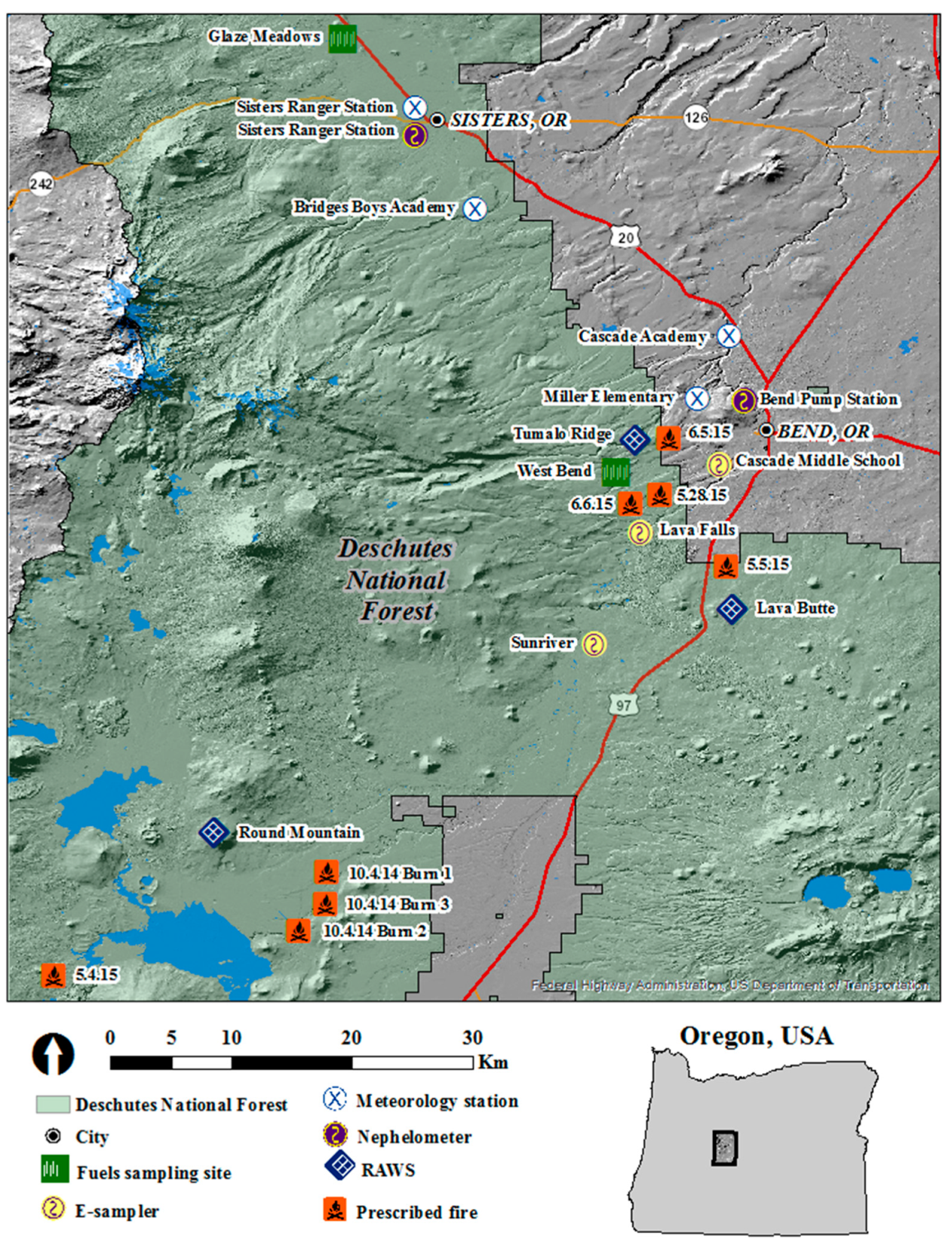
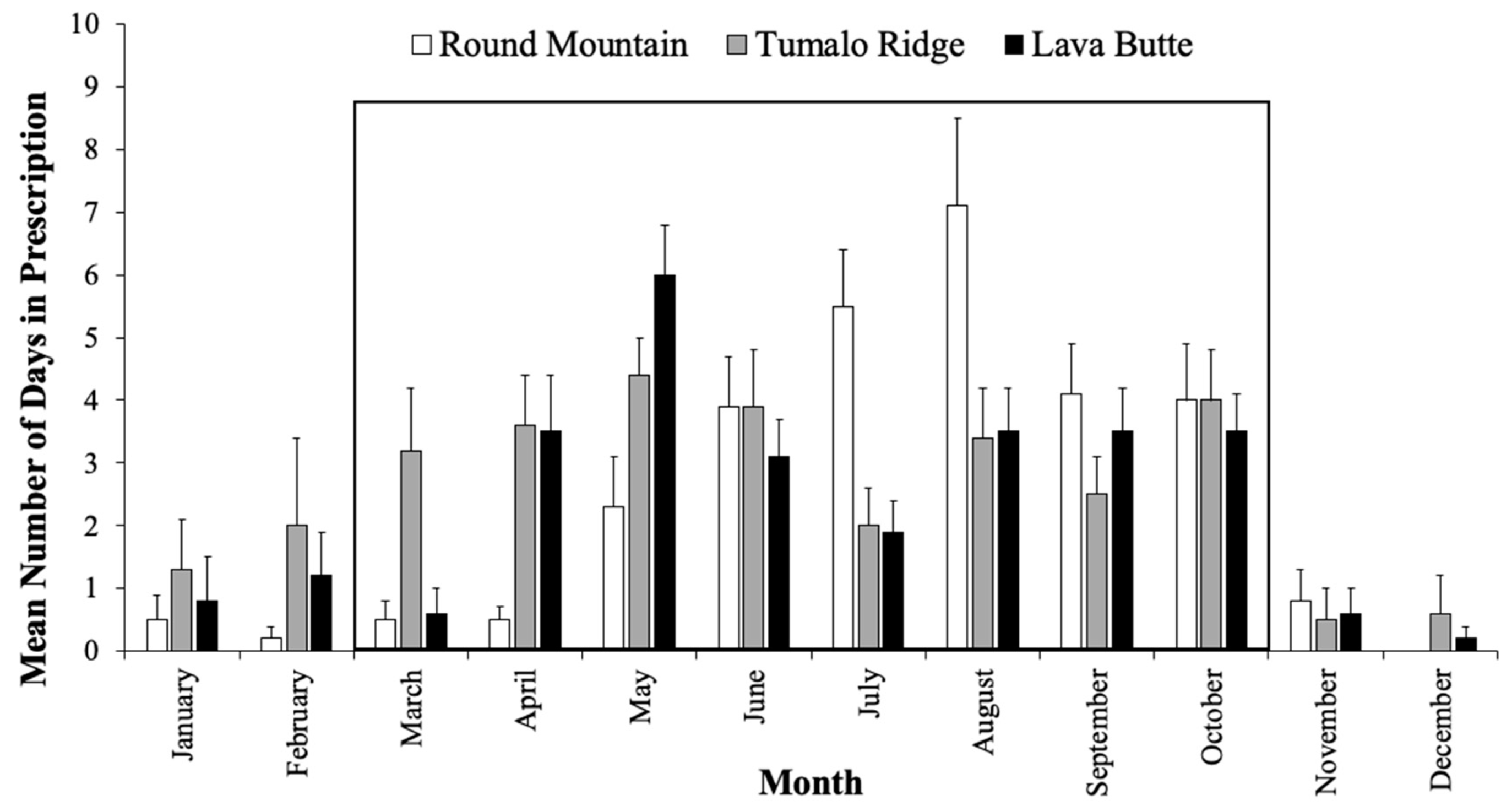
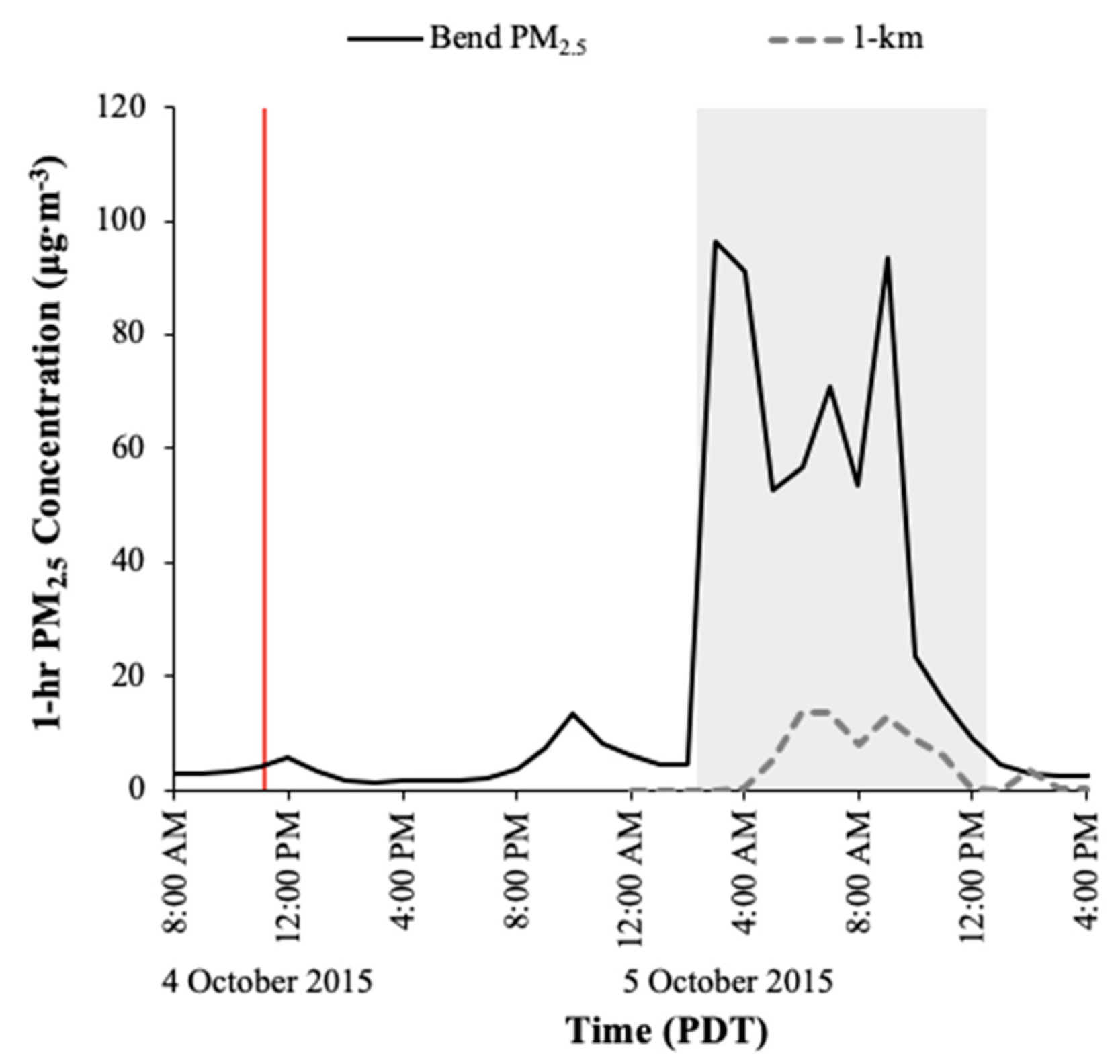
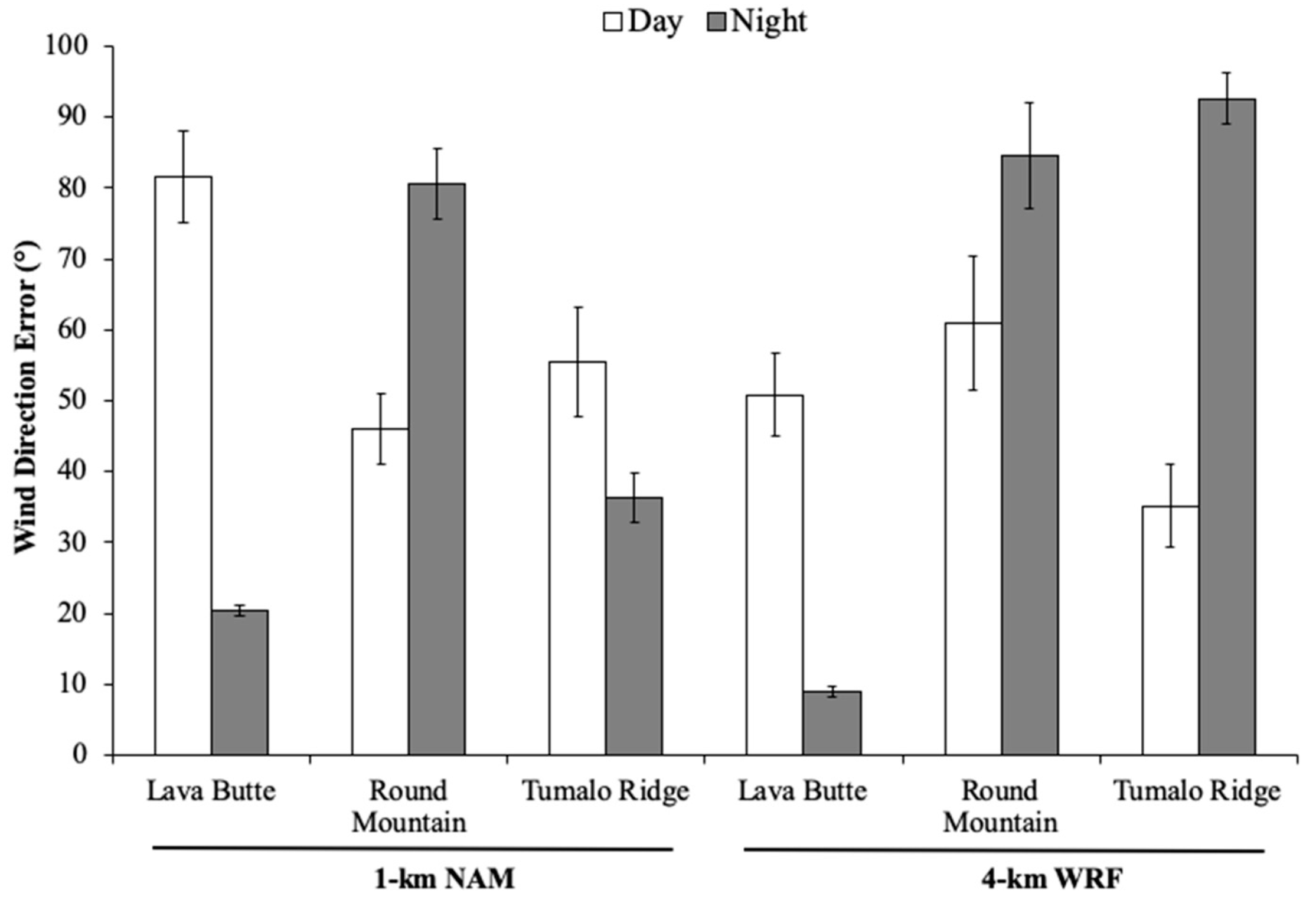
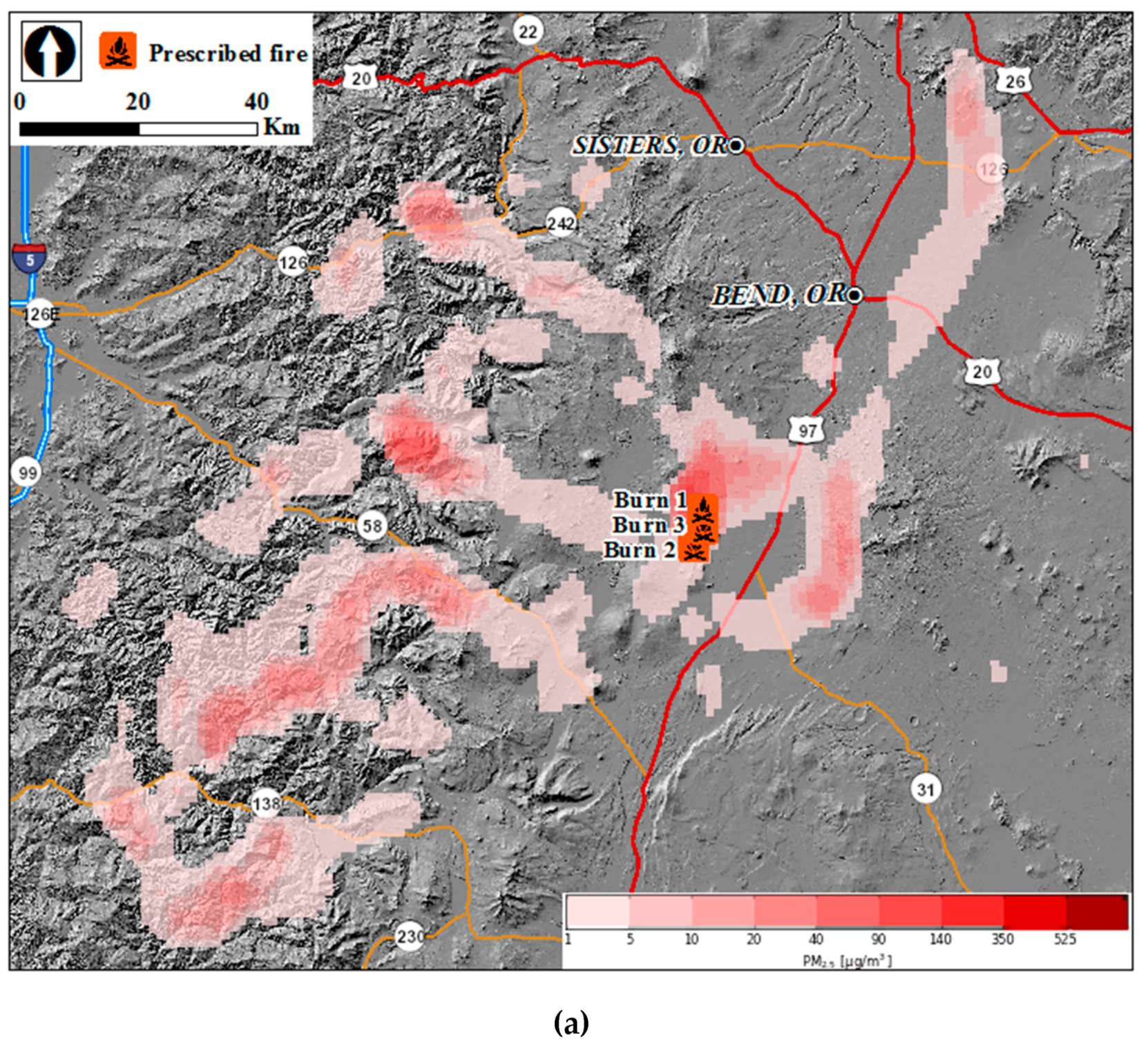
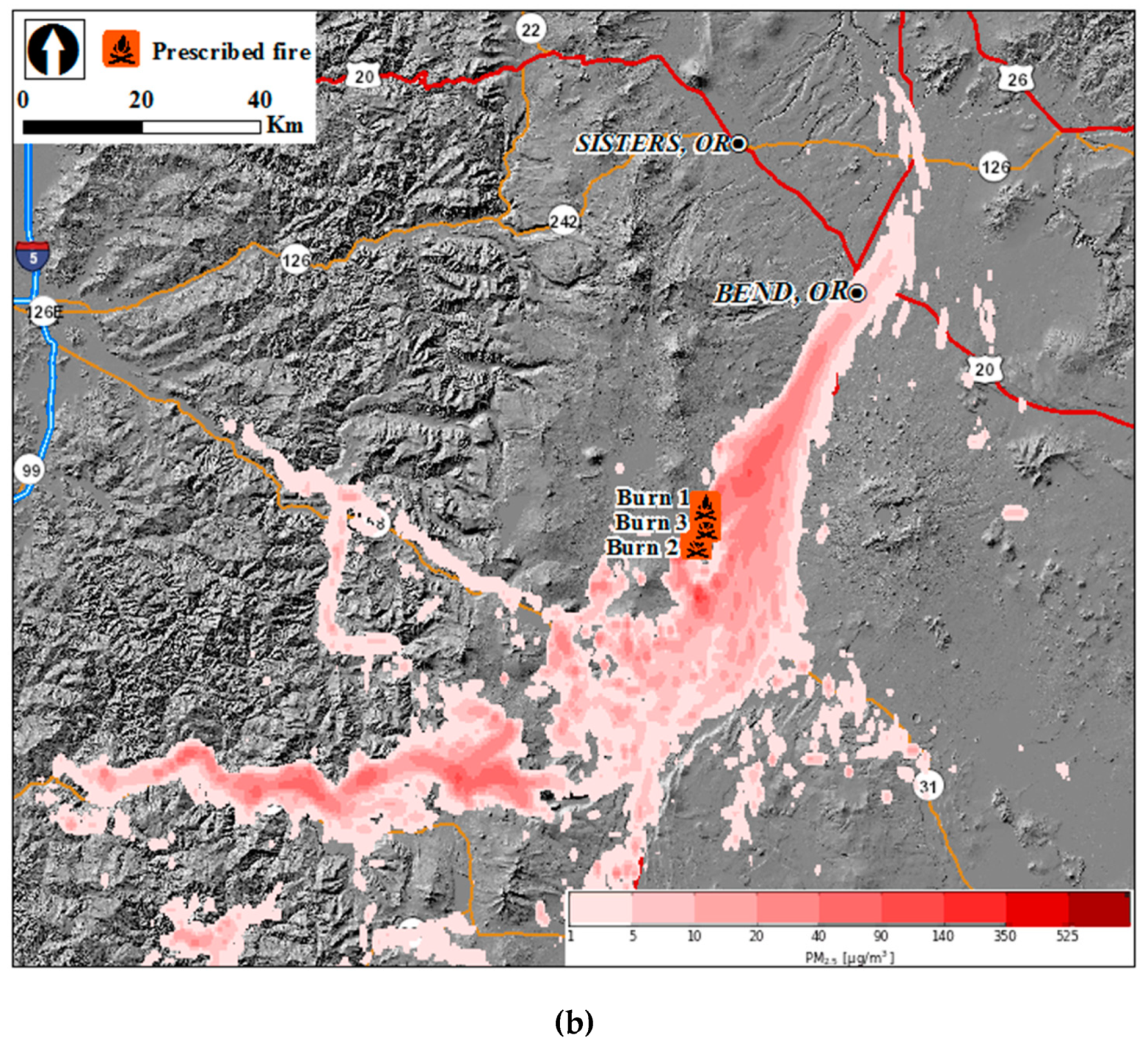
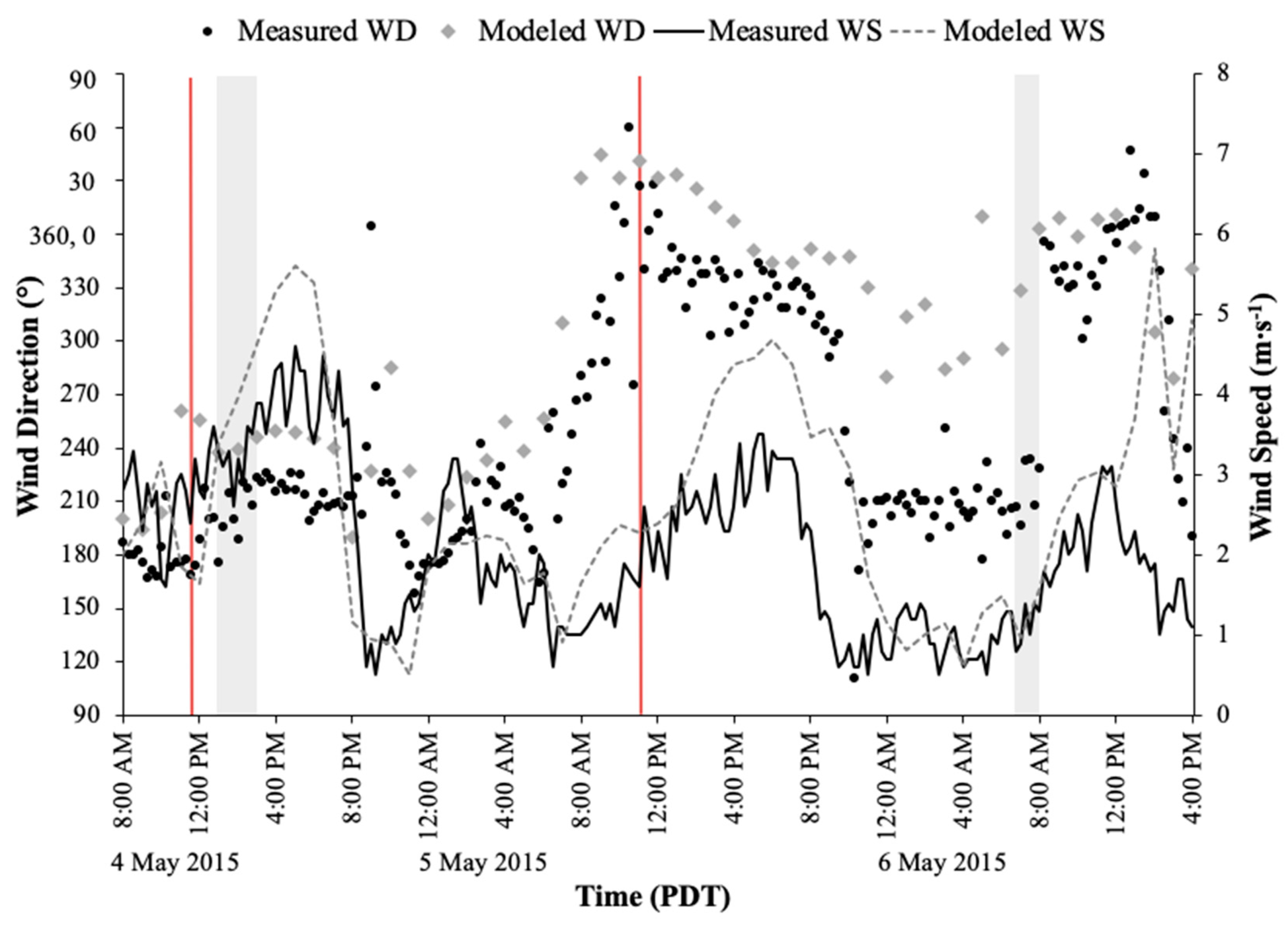
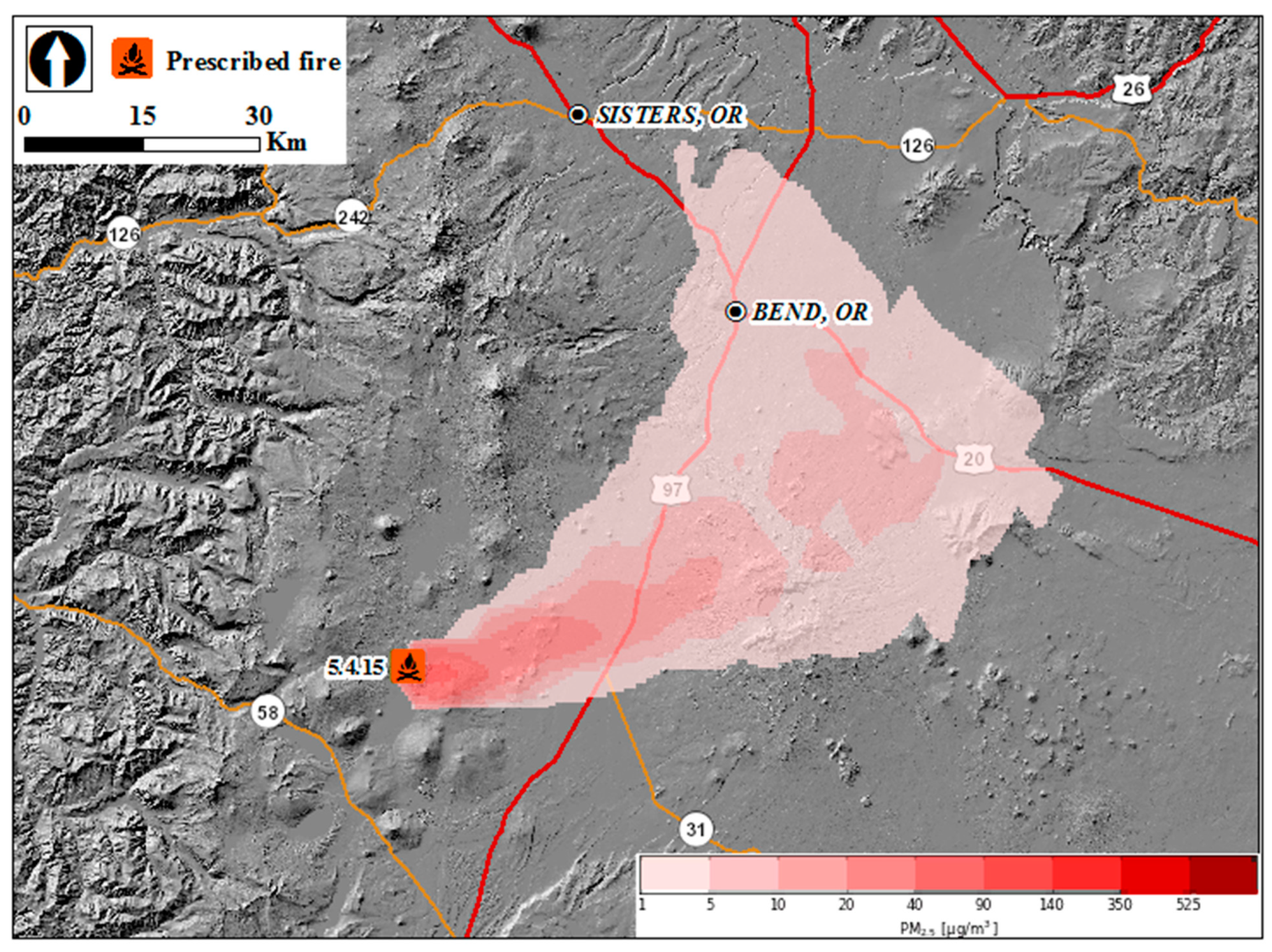
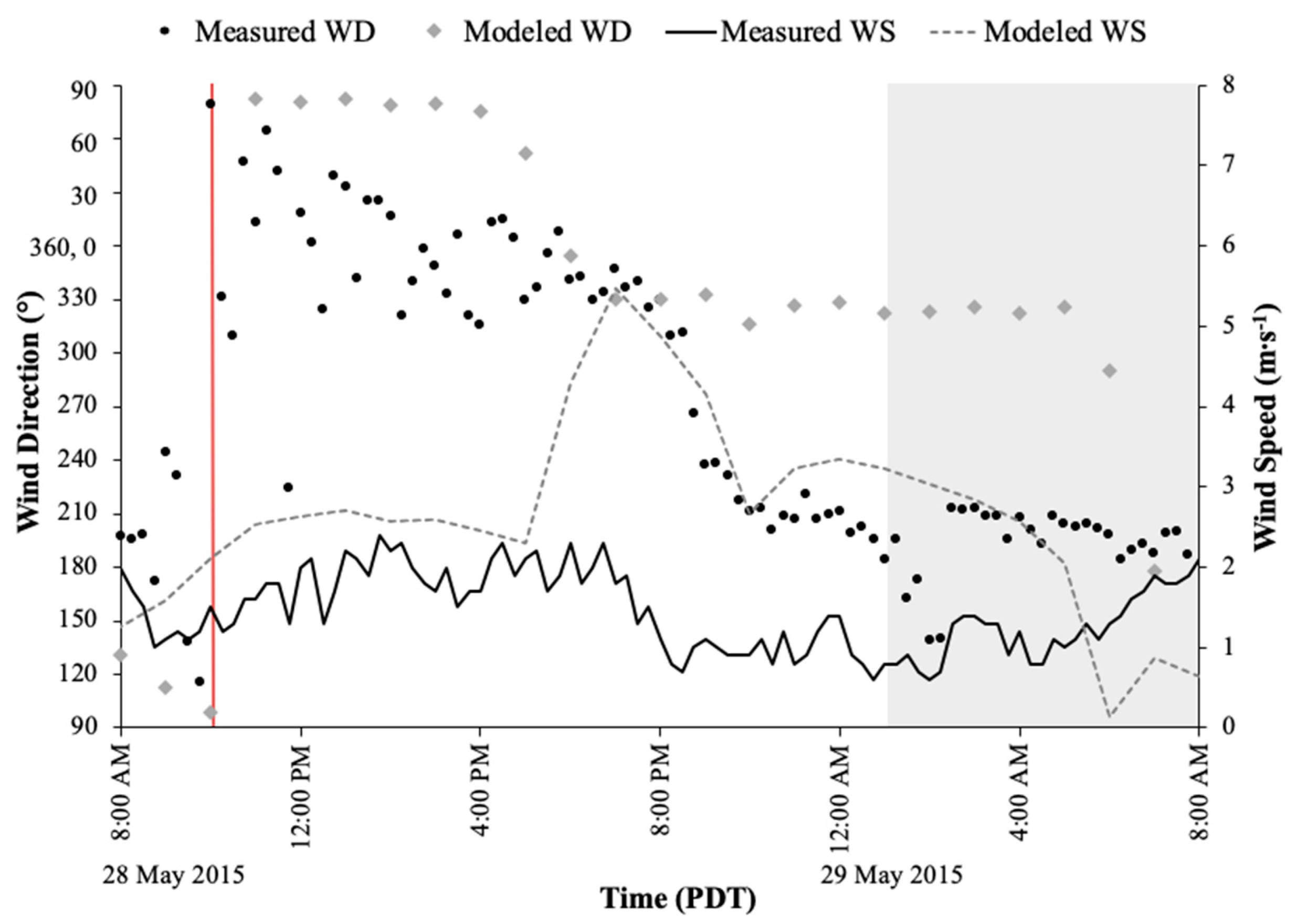
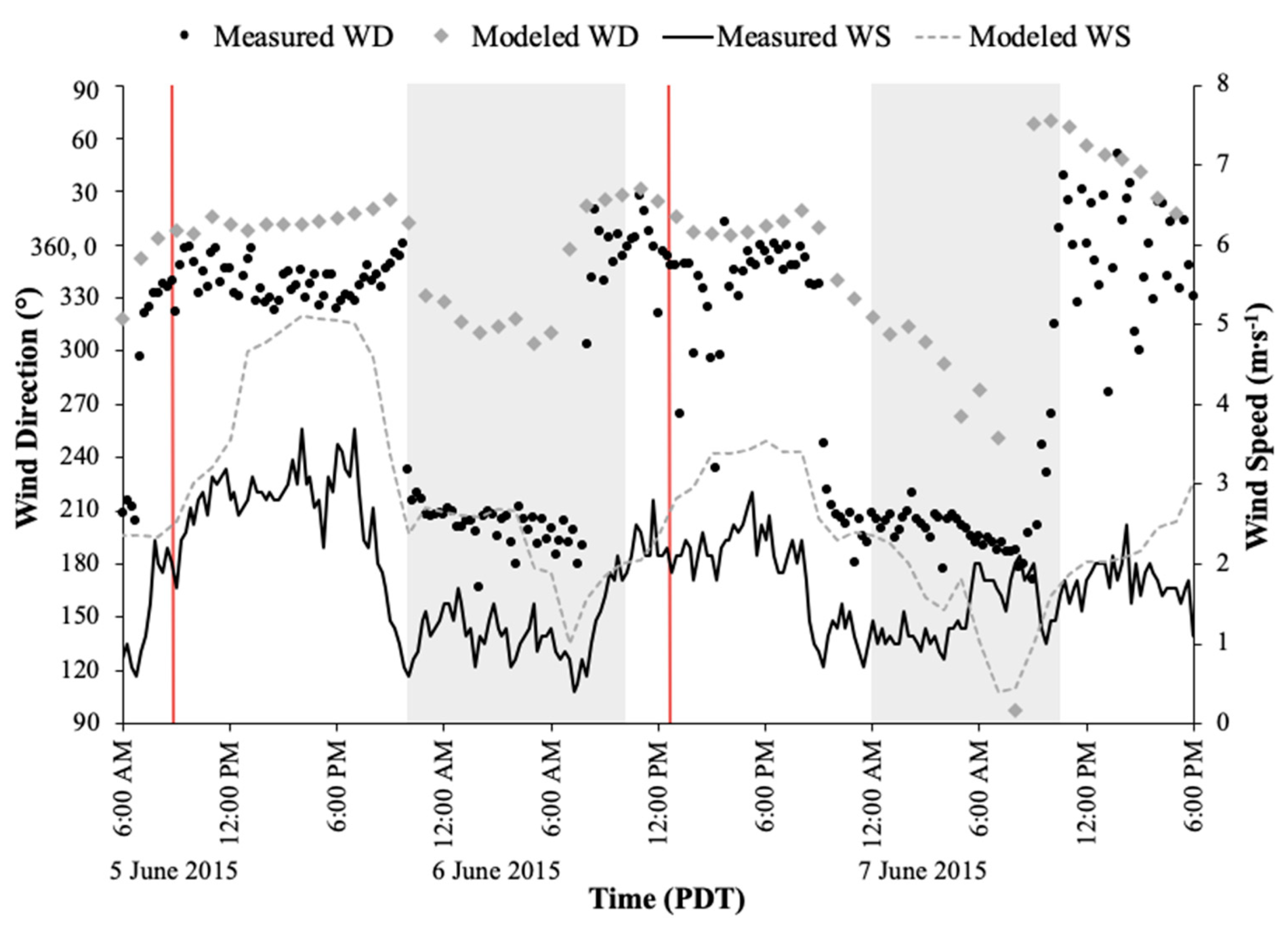
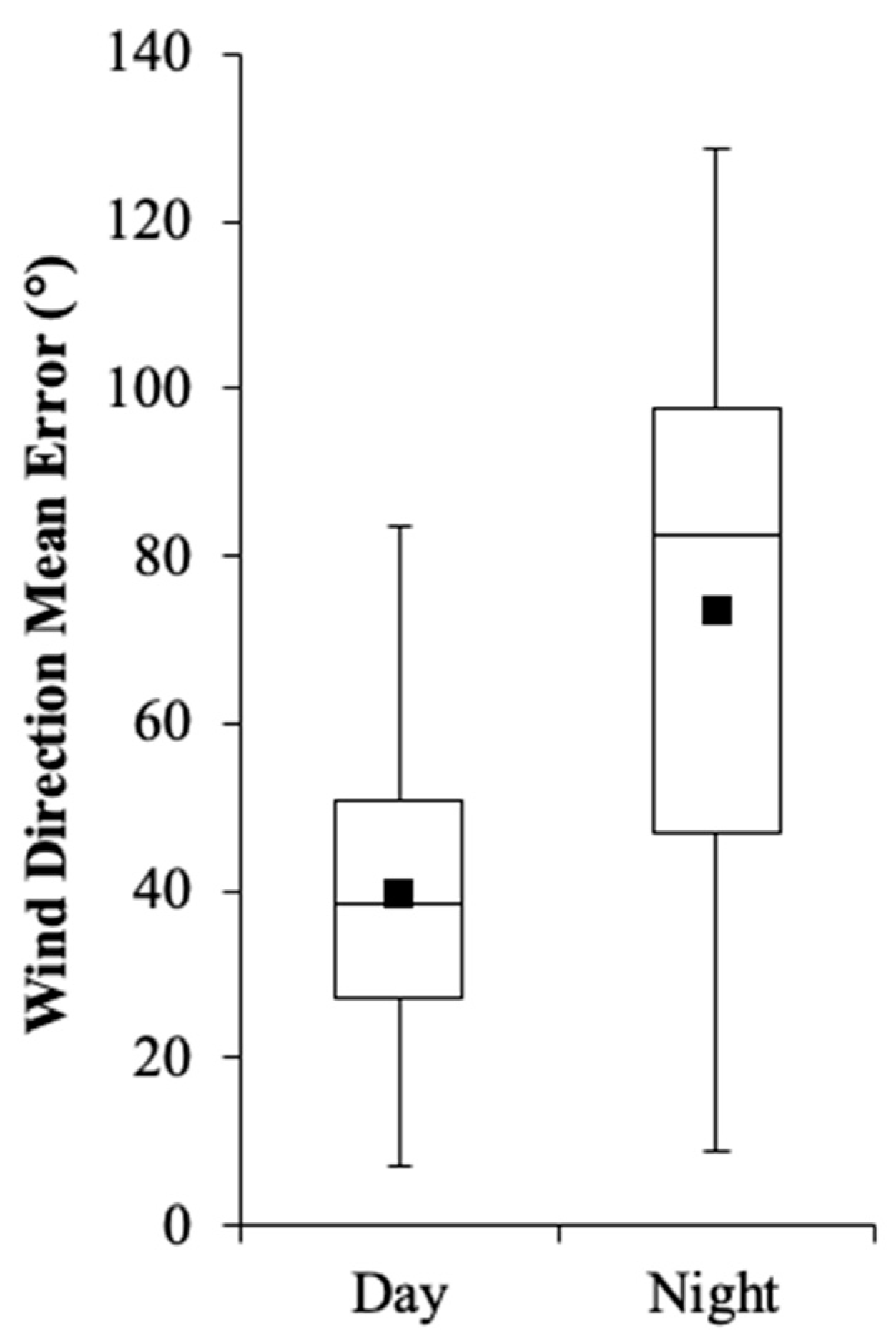
| Parameter | Low | High | Minimal Acceptable Moisture Parameters |
|---|---|---|---|
| Air Temperature (°C) | 4.4 | 26.7 | - |
| Relative humidity (%) | 20 | 40 | - |
| Mid-flame wind speed (m∙s−1) | 0 | 3.6 | - |
| 1-h fuel moisture (%) | 5 | 10 | 5 |
| 10-h fuel moisture (%) | 6 | 12 | 6 |
| 100-h fuel moisture (%) | 7 | 14 | 7 |
| 1000-h fuel moisture (%) | - | - | 15 |
| Live fuel moisture (%) | - | - | 30 |
| Station | Latitude (°) | Longitude (°) | Elevation (m) | Measurement Type | Relationship to Bend, Oregon (km, direction) |
|---|---|---|---|---|---|
| Sisters Ranger Station | 44.2925 | −121.5552 | 975 | WX | 32 km, NNW |
| Sisters Ranger Station | 44.2925 | −121.5552 | 975 | Nephelometer | 32 km, NNW |
| Bridges Boys Academy | 44.2274 | −121.5212 | 1079 | WX | 25 km, NW |
| Cascade Academy | 44.1327 | −121.3323 | 988 | WX | 8 km, NNW |
| Tumalo Ridge | 44.0494 | −121.4003 | 1220 | RAWS | 7 km, WSW |
| Bend Pump Station | 44.0639 | −121.3126 | 1101 | Nephelometer | In Bend |
| Miller Elementary | 44.0543 | −121.3692 | 1167 | WX | 5 km, W |
| Cascade Middle School | 44.0370 | −121.3397 | 1145 | PM2.5 | 4 km, SW |
| Lava Butte | 43.93 | −121.33 | 1344 | RAWS | 15 km, S |
| Sunriver | 43.9033 | −121.4329 | 1269 | PM2.5 | 20 km, SSW |
| Round Mountain | 43.6739 | −121.7167 | 1798 | RAWS | 47 km SW |
| Burn Date | Latitude (°) | Longitude (°) | Elevation (m) | Size (ha) | Pre-fire Fuel Loading (kg∙ha−1) | Vegetation Type | Ignition Start (PDT) |
|---|---|---|---|---|---|---|---|
| 4 October 2014 | 43.7250 | −121.6323 | 1301 | 18.2 | 101,482 | Lodgepole pine | 1:57 PM |
| 4 October 2014 | 43.6960 | −121.6529 | 1305 | 19.0 | 44,498 | Pacific Ponderosa pine; Douglas fir | 11:14 AM |
| 4 October 2014 | 43.7105 | −121.6329 | 1302 | 20.3 | 44,498 | Pacific Ponderosa pine; Douglas fir | 11:30 AM |
| 4 May 2015 * | 43.6571 | −121.8360 | 1525 | 46.2 | 182,990 | Lodgepole pine | 9:30 AM |
| 5 May 2015 | 43.9611 | −121.3339 | 1266 | 4.9 | 30,734 | Ponderosa pine savanna | 10:45 AM |
| 28 May 2015 | 44.0242 | −121.3839 | 1312 | 27.9 | 21,005 | Western juniper; sagebrush savanna | 11:25 AM |
| 5 June 2015 | 44.0423 | −121.3975 | 1220 | 49.4 | 21,005 | Western juniper; sagebrush savanna | 11:00 AM |
| 6 June 2015 | 44.0136 | −121.3975 | 1234 | 55.9 | 21,005 | Western juniper; sagebrush savanna | 10:00 AM |
| Burn Date | Intrusion Start (PDT) | Intrusion Duration (h) | Maximum 1-h PM2.5 (μg∙m−3) | Maximum 24-h PM2.5 (μg∙m−3) | Relationship to Bend, Oregon (km, direction) |
|---|---|---|---|---|---|
| 4 October 2014 | 3:00 AM. 5 October 2014 | 10 | 96 | 26 | 45 km, SSW |
| 4 October 2014 | 49 km, SSW | ||||
| 4 October 2014 | 47 km, SSW | ||||
| 4 May 2015 | 1:00 PM. 4 May 2015 | 2 | 13 | 5 | 60 km, WSW |
| 5 May 2015 | 7:00 AM. 6 May 2015 | 1 | 11 | 2.3 | 11 km, SSW |
| 28 May 2015 | 1:00 AM. 29 May 2015 | 7 | 181 | 27 | 7 km, SW |
| 5 June 2015 | 10:00 PM. 5 June 2015 | 12 | 130 | 25 | 7 km, WSW |
| 6 June 2015 | 12:00 AM. 7 June 2015 | 10 | 245 | 38 | 9 km, SW |
| BlueSky Framework | Version 3.1.5 |
| Meteorological Model | Weather Research and Forecasting (WRF) 3.1.1 (4-km, 1-h intervals); North American Mesoscale Forecast System (NAM) (1-km, 1-h intervals) |
| Fuel Loadings | Fuel Characteristic Classification System (FCCS) |
| Consumption Model | Consume Version 3.0 |
| Emissions Model | Fire Emission Production Simulator (FEPS) Version 1.0 |
| Dispersion Model | Hybrid Single-Particle Langrangian Integrated Trajectory (HYSPLIT) Version 4.9 |
| Time of Year | Day North Wind Yes | Day North Wind No | Night South Wind Yes | Night South Wind No | “Ideal” Wind Conditions |
|---|---|---|---|---|---|
| Annual | 36% | 45% | 77% | 15% | 7% |
| Annual burn | 46% | 38% | 75% | 17% | 8% |
| Spring | 45% | 36% | 77% | 12% | 7% |
| Spring burn | 50% | 36% | 69% | 21% | 13% |
| Fall | 35% | 44% | 77% | 17% | 9% |
| Fall burn | 46% | 38% | 80% | 14% | 5% |
| Station | 4–6 May 2015 | 28–29 May 2015 | 5–7 June 2015 | |||
|---|---|---|---|---|---|---|
| WS Bias/Error (m∙s−1) | WD Error (°) | WS Bias/Error (m∙s−1) | WD Error (°) | WS Bias/Error (m∙s−1) | WD Error (°) | |
| Sisters Ranger Station | 2.9/3.0 (50% calm) | 49.3 | 1.7/1.7 (88% calm) | 43.5 | 2.5/2.5 (79% calm) | 47.3 |
| Bridges Boys Academy | 1.3/1.5 (40% calm) | 43.1 | 1.1/1.4 (63% calm) | 48.0 | 1.1/1.1 (44% calm) | 27.2 |
| Cascade Academy | 2.0/2.0 (67% calm) | 43.8 | 1.3/1.3 (71% calm) | 45.4 | 2.8/2.8 (63% calm) | 38.3 |
| Tumalo Ridge RAWS | 0.6/1.1 | 42.9 | 0.6/0.9 | 58.6 | 0.9/1.1 | 40.8 |
| Miller Elementary | 1.6/1.8 (52% calm) | 33.8 | 1.8/1.8 (79% calm) | 70.2 | 2.6/2.6 (56% calm) | 29.7 |
| Cascade Middle School | 0.4/0.7 | 59.9 | 0.7/1.0 | 85.4 | 0.9/1.1 | 74.3 |
| Lava Butte RAWS | 0.7/1.4 (10% calm) | 34.8 | 0.9/1.3 (33% calm) | 59.4 | 2.0/2.0 (19% calm) | 39.2 |
| Sunriver | −0.6/1.0 (31% NA) | 71.2 | 0.4/1.2 | 94.0 | 0.9/1.1 | 55.4 |
| Round Mountain RAWS | −0.2/1.4 | 13.8 | −0.7/1.5 | 59.5 | 0.1/1.6 | 62.6 |
© 2019 by the authors. Licensee MDPI, Basel, Switzerland. This article is an open access article distributed under the terms and conditions of the Creative Commons Attribution (CC BY) license (http://creativecommons.org/licenses/by/4.0/).
Share and Cite
Miller, C.; O’Neill, S.; Rorig, M.; Alvarado, E. Air-Quality Challenges of Prescribed Fire in the Complex Terrain and Wildland Urban Interface Surrounding Bend, Oregon. Atmosphere 2019, 10, 515. https://doi.org/10.3390/atmos10090515
Miller C, O’Neill S, Rorig M, Alvarado E. Air-Quality Challenges of Prescribed Fire in the Complex Terrain and Wildland Urban Interface Surrounding Bend, Oregon. Atmosphere. 2019; 10(9):515. https://doi.org/10.3390/atmos10090515
Chicago/Turabian StyleMiller, Colton, Susan O’Neill, Miriam Rorig, and Ernesto Alvarado. 2019. "Air-Quality Challenges of Prescribed Fire in the Complex Terrain and Wildland Urban Interface Surrounding Bend, Oregon" Atmosphere 10, no. 9: 515. https://doi.org/10.3390/atmos10090515
APA StyleMiller, C., O’Neill, S., Rorig, M., & Alvarado, E. (2019). Air-Quality Challenges of Prescribed Fire in the Complex Terrain and Wildland Urban Interface Surrounding Bend, Oregon. Atmosphere, 10(9), 515. https://doi.org/10.3390/atmos10090515





